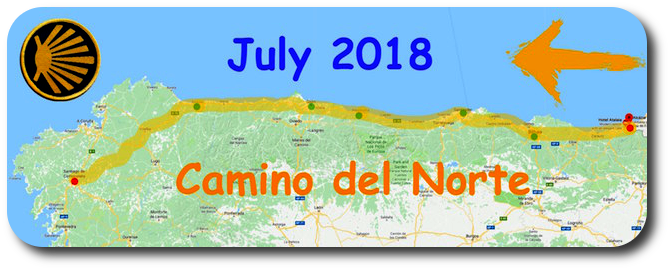

In July 2018 Anthony and I set off on our epic walk across Northern Spain. Starting in Irun on the French border we walked through four provinces, ending in Santiago de Compostela more than five weeks later.
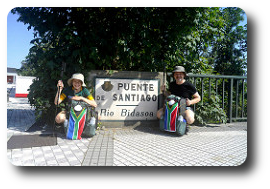 Basque Country (166km) |
 Cantabria (173km) |
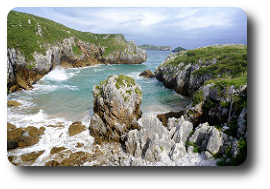 Asturias (274km) |
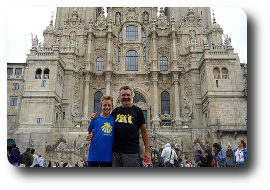 Galicia (209km) |
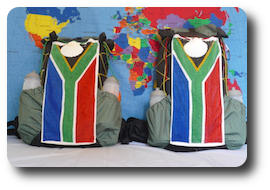 |
After months of planning, changing plans, choosing equipment, changing our minds about equipment, trying different types of socks, we gathered together all we needed and developed a fairly good idea of what lay ahead of us. |
|
I started training two months in advance by walking to work and back and all over town.
Anthony joined me on my daily walks to work with fully loaded backpacks during the last week.
Here follows the day-by-day story of our journey, accompanied by some photos taken with our mobile phones... |
 |
We covered at least 822km during the 37 days spanning 1 July to 6 August, walking an average of about 23km each day, stopping only once for a rest day. Some days we took it easy and walked fewer than 20 kilometres. Other days we had to catch up by covering over 30 kilometres per day, which was always very tough - especially for a 14 year old kid.
We used the excellent "Village to Village" Camino del Norte guide book which breaks the journey up into 37 stages - and coincidentally we had exactly 37 days. So, starting on Sunday 1 July we followed the guide book fairly closely, though not exactly - having to "catch up" a few times along the route.
| 1. | 23km | San Sebastian | 23km | |
| 2. | 24km | Zarautz | 47km | |
| 3. | 12km | Zumaia | 59km | |
| 4. | 17km | Bario Ibiri (Izarbide) | 76km | |
| 5. | 27km | Monasterio de Zenarruza | 103km | |
| 6. | 28km | Eskerika | 131km | |
| 7. | 21km | Bilbao | 152km | |
| 8. | 14km | Portugalete | 166km | |
| 9. | 28km | Castro-Urdiales | 194km | |
| 10. | 24km | Liendo | 218km | |
| 11. | 21km | Noja | 239km | |
| 12. | 15km | Güemes | 254km | |
| 13. | 15km | Santander | 269km | |
| 14. | 18km | Requejada | 287km | |
| 15. | 22km | Cóbreces | 309km | |
| 16. | 30km | Serdio | 339km | |
| 17. | 35km | Llanes | 374km | |
| 18. | 24km | Cuerres | 398km | |
| 19. | 13km | La Vega | 411km | |
| 20. | 25km | Sebrayo | 436km | |
| 21. | 28km | Deva | 464km | |
| 22. | 33km | Avilés | 497km | |
| 23. | 23km | Muros de Nalón | 520km | |
| 24. | 0km | |||
| 25. | 16km | Soto de Luiña | 536km | |
| 26. | 19km | Cadavedo | 555km | |
| 27. | 32km | Piñera | 587km | |
| 28. | 26km | Tapia de Casariego | 613km | |
| 29. | 34km | Gondán | 647km | |
| 30. | 34km | Gontán | 681km | |
| 31. | 21km | Vilalba | 702km | |
| 32. | 19km | Baamonde | 721km | |
| 33. | 15km | Miraz | 736km | |
| 34. | 25km | Sobrado dos Monxes | 761km | |
| 35. | 22km | Arzúa | 783km | |
| 36. | 19km | Arca | 802km | |
| 37. | 20km | Santiago de Compostela | 822km |
Sat 30 Jun, 23Km (23km)
On the morning of our first full day in Spain we arrived at San Sebastian airport, which is not in San Sebastian itself but closer to Irun on the French-Spanish border where the 830km Camino del Norte officially starts.
| From the airport we walked to Irun and headed straight to the Albergue de peregrinos de Irun run by the Association of Friends of the Caminos de Santiago, where we were greeted by the friendly "hospitalera". We asked her where we might be able to buy walking poles, not so much to walk with but to use as tent poles when we camp along the way (we were unable to fly with ours as carry-on luggage). She told us that all the shops in town were closed due to the festivities... and then we had our first experience of the "camino spirit" as she handed us a pair of walking poles that some generous pilgrim had left there the day before so that other pilgrims could use them :) | 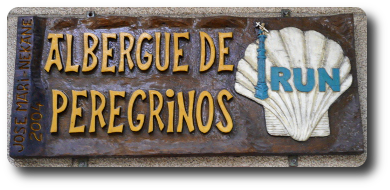 |
 |
It was a blistering hot day as we made our way through town to the "Puente de Santiago" bridge over the Rio Bidasoa that forms the border with France and is the "official" start of the Camino del Norte. We took a photo on the spot where an old, faded "830km" is painted on the pavement. |
|
30 June happens to be the day of San Marcial, when the people of Irun hold a fiesta with street parades to celebrate their victory over French troops in 1522. So the locals, young and old, were all dressed up in white and red, walking around town with fake and real guns, marching in street parades and partying through the night. |
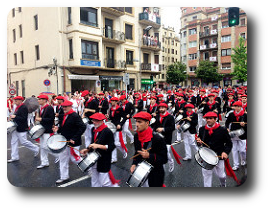 |
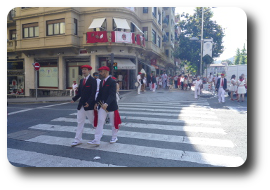 |
After a lunch of bread with jamon and cheese we made our way back to the albergue, passing a church along the way when a gentleman dressed in white and red walked out of a pub across the road to come and greet us. He had seen our South African flags (actually small hand towels) hanging from our backpacks, and wanted to tell us what a beautiful country South Africa is, how much he enjoyed his recent holiday there and how friendly the people were towards him. He wanted us to feel welcome in the Basque country - us welcome as he felt in our country - and wished us a successful Camino with the words we were to hear often on our journey ahead: Buen Camino! |
|
When we reached the albergue we waited outside in the queue that had already started to form. Was this an omen of how things to come... albergues filling up causing pilgrims to rush to find a bed each night..? Having secured our bed for the night, we headed back into town to witness the festivities, taking our ponchos with as rain seemed imminent. No sooner had we arrived than it started pouring rain, but it didn't put much of a damper on proceedings as the parades continued and spectators flocked to the streets. |
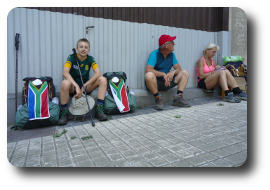 |
Arriving back to spend our first night in a pilgrim's hostel, I felt excited yet slightly nervous about the huge challenge that lay ahead, so I decided that we would set our alarms for 5am so that we could hit the road by 6am...
 |
I was impressed by the number of people in the streets all dressed in white and red as part of the annual celebratory event.
There was a strong sense of patriotism among the people there who came to spectate and participate in spite of the horrible, rainy weather.
|
Sun 1 Jul, 23Km (23km)
It was a cool misty morning as we headed out of town, passing some drunk revellers on the streets of Irun who had been out partying all night, with the odd empty bottle or shattered glass on some pavements.
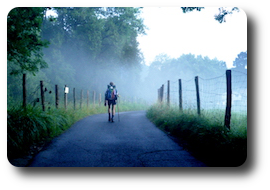 |
Soon we were heading along a river and into the hills towards San Sebastian, surrounded by fog with the sun slowly rising on our right. Near the top we stopped at the "Ermita de Guadalupe" for our first rest where we took off our backpacks and admired the view towards France. A bit further the path split between the higher (and tougher) route over the mountains, and the somewhat easier contour path. |
|
This is where we met Sean from England, the "Pagan on a Plgrimage" (Hiking like a Viking). Our paths were to cross several times along our journey and eventually we'd meet again on our last day's walk into Santiago de Compostela. After a brief chat we all decided to go along the contour path, which was the sensible choice as it was only our first day on the camino and we hadn't reached full walking fitness yet. |
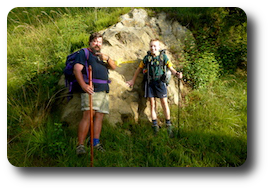 |
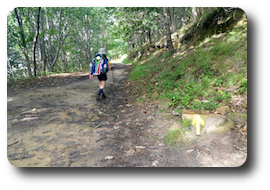 |
The walk along the contour was pleasant with cool weather, though Anthony started feeling some mild muscle pain behind his left knee. I rubbed some Voltaren cream into his aching muscles, and within half an hour he started feeling some relief. |
|
Soon we reached the very steep descent down into "Pasajes de San Juan", a quaint seaside village down in a narrow valley. Here we stopped for our first snack as we came across Sean who had walked ahead and was now causually sitting at an outdoor restuarant with his bare feet and beer in hand. Following his example we also took off our shoes (every bit of foot relief is valuable!) to air our boots and socks and feet. |
 |
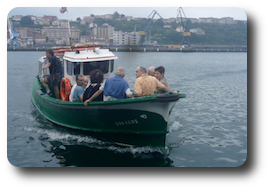 |
We also had our credentials stamped at the restaurant, but it was a fairly insignifcant business stamp that took up far too much space, so I decided to conserve the credential real estate by (mostly) only getting stamps at the places we stopped to sleep for the remainder of our journey. After a light lunch of chips + beer/Pepsi we crossed the river on a small ferry boat. |
|
On the other side was the inevitable uphill, and what an uphill it was! A group of cyclists who crossed on the ferry with us had to pick up their bicycles and carry them up those steep steps in the stifling heat... which made our backpacks far less of a burden by comparison. |
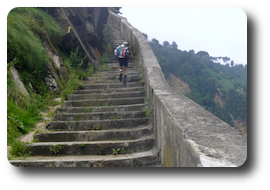 |
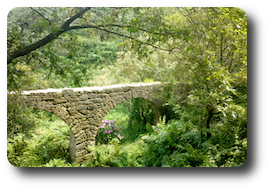 |
Once we reached the top our walk was a pleasant meander through forests along old pathways and over ancient stone bridges. |
|
Though the surroundings were beautiful, we were starting to tire so we looked forward to reaching San Sebastian. |
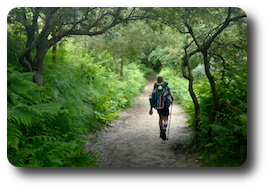 |
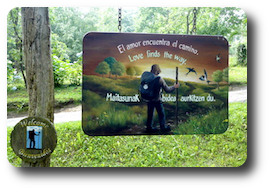 |
However, about 3km before our destination we found a veritable oasis: Doce Tribus (Twelve Tribes) - a kind of hippie/religious community living in a large house surrounded by beautiful gardens. The hosts were very warm and friendly, offering us some kind of homemade lemonade drink while we took off our shoes. |
|
They allow pilgrims to pitch tents in their garden, so we decided to spend the night there even though we hadn't reached our intended destination. So, with rain threatening we decided to spend the night there and proceeded to pitch our tent: a cheap inner + ground sheet with a simple tarp over it. Our host lent us some tent pegs as security at Madrid airport had confiscated my (expensive) titanium tent pegs (because you can take a knife with a 6cm blade onboard but you dare not take a tent peg which could be used to stab someone...) |
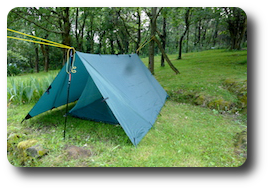 |
The albergue in which we slept that night, called "Doce Tribus", was lovely and is run entirely on donations. They had a beautiul garden in which they allowed us to pitch our tent. In the evening, they ate supper with us and the other guest staying there with us. It's a great place that I'd encourage anyone who walks the Camino Del Norte to stay at. It is about three kilometers before San Sebastian so you would have a tough day of walking ahead of you the next day if you did so, but it's worth it!
Mon 2 Jul, 24Km (47km)
|
Having not walked the full 26km to San Sebastian, we rose at the break of dawn to get an early start to make up the 3km shortfall. We had slept really well with the sound of light rain on our tarp and the morning air crisp and fresh. Anthony commented how "it looks like a cool day". I told him to mark those words and we'll see what it's like later in the day... Our hosts invited us to join them for breakfast, where Anthony knocked their beautiful glass honey jar onto the floor, shattering to pieces. Maybe it was his enthusiasm for the freshly baked "Magdalenas" (small muffins) that caused his carelessness. After I scolded him for not putting it deeper on the table as I always keep telling him, our host seemed to take pity on the poor lad and handed him a small brown paper bag full of Magdalenas for the road. |
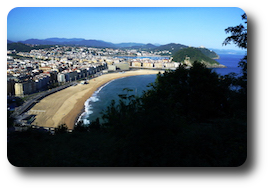 |
 |
The downhill to San Sebastian was tough on our knees and toes as we made our way into town hoping to find a shop where we could buy tent pegs. We stopped at the albergue where we would have stayed if we had walked all the way to San Sebastian the day before to ask if there are any outdoor shops in town. While a friendly, helpful gent went into the back office to print out a map for us, a stocky older woman entered and started telling us in angry Spanish that we must leave immediately. She must have thought we were leftover guests from the previous night, and I tried to politely explain in my broken Spanish that we weren't here for accommodation - that we were only asking for directions and that we were already being helped. But she would have none of it as she kept insisting that we must leave NOW because "estamos cerrado!" Luckily a younger lady calmed her down and shortly after the gent came out with the map and showed us how to get to the outdoor shop. I felt like waving my index finger at her like the scene from Withail and I leaving the tearoom as we took the map and told her: look, we're leaving now... |
|
The shop was closed, so we grabbed a quick fruit juice at the terrace cafe across the road. Eating outdoors is one of the things I love about Mediterranean countries. It turns out that the outdoor shop had just about everything except tent pegs... but they did have packets of wooden chopsticks, so I bought a few, as well as a cheap pen knife (as I wasn't sure if we'd be allowed to fly with a pen knife - how ironic that a pen knife may have been fine but not relatively blunt tent pegs!) We didn't have time left over to spend in San Sebastian - the place with the largest concentration of Michelin Star restaurants in the world - so I hope to return one day to spend more time. On our way out we bought a bunch of fresh "paraguayos" - flat peaches with red-ish skins and deliciously sweet white flesh. These were to become favourites on our camino as we developed the habit of having fresh fruit every day for first breakfast. After a tough uphill out of the valley we came across a refreshment station with foldup chairs and a table with fresh cold water and "sellos" (stamps) for our credentials. There was a sign explicitly asking pilgrims NOT to make donations - to just sit and rest and help ourselves to water. We were soon joined by a group of Mexican walkers who, after some friendly banter, sped ahead because the Football World Cup was on and Mexico was playing later that day, so they wanted to reach a sports bar in Orio in time to watch the match... |
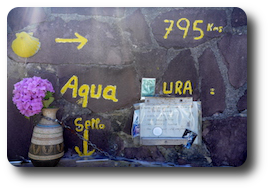 |
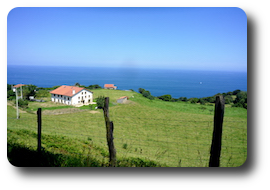 |
The road to Orio felt long and tough in the heat of the day. We kept meeting the same couple of Belgian walkers who were just doing a (full) day walk. They walked at a snail's pace but kept going. We would pass them with ease, and then stop for a rest up ahead, when they would pass us. This kept repeating itself and we soon learned the value of taking it slow and not stopping. However, stopping to take in the scenery is as much part of the journey for me - the tric being to find the best spots to stop at. At one stage we found a beautiful forest mountain stream where we stopped to refresh - and our Belgian friends simply walked past with their eyes nailed to the path in front of them, completely oblivious to the little oasis right next to it! |
|
I reminded Anthony of his "looks like a cool day" observation early that morning as we sweated along our way, refilling our water bottles and keeping ourselves hydrated in the dry heat of the day. |
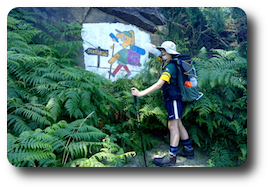 |
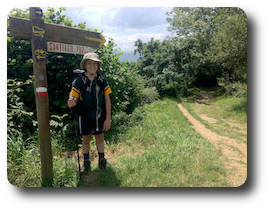 |
Our end destination was still 787km ahead of us, and I wondered if we would be able to keep up the pace for 37 full days... We passed a restaurant around 1pm that we came across, seemingly in the middle of nowhere, and popped inside briefly to see if we could find a table to have lunch, as we were already quite hungry. It was packed inside, though, and the waiter told us that all the tables, inside and out, were already fully booked for lunch as locals were arriving from all directions. So we decided to push ahead and find a place to eat in the next village. |
|
The scenery was breathtaking as we continued on our way towards Orio, where we found a place that was showing the football match indoors. But we decided to sit in the shade outside to enjoy ice cold drinks: beer for me and a Coke for Anthony, accompanied by torillas and some delicious tapas, satisfying the hunger that grew after we had bypassed lunch earlier. Occasionally yells of delight and/or despair as Mexico and Brazil faced each other off in their "Round of 16" football match. But we were too tired to be active spectators as we rested our tired legs and aired our feet on the cool cement floor. |
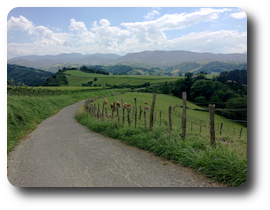 |
 |
Feeling somewhat energized after our late lunch we headed off on the last stretch of the day towards "Gran Camping" just before Zarautz. Along the way we met up with our Mexican friends, who were somewhat more subdued after their country's loss to Brazil (and a good few beers, I reckon!). The last uphill to "Gran Camping" was really though and the blind rises seemed never ending... Eventually we made it to our campsite where we pitched our tent amongst the many holidaymakers and surfers up on the hill with views across the sea. We also got into the daily routine that we would follow the rest of our journey, of showering and washing our underwear and socks as soon as we arrive at our destination for the night. To end off our tough but satisfying day we grabbed some food and walked to the edge of the campsite to enjoy supper while the sun set over the sea... |
 |
Just on the other side of San Sebastian, we found a water refill station where we refilled our bottles and got stamps. There was a sign at the station saying not to donate any cash to thank the people running it. This was our second experience of the "Camino Spirit."
|
Tue 3 Jul, 12Km (59km)
|
After striking our tent we headed along the path down to Zarautz, stopping at a wooden bench overlooking the beach that is known for its good surf. In fact, an international surf championship is held every year in Zarautz, and there was an abundance of surf schools in town (note to self: keep this in mind as a future surfing holiday destination...) Our breakfast consisted of bread rolls with condensed milk, which was to become a favourite as it was easier to carry condensed milk which came in light plastic tubes (like toothpaste) whereas honey was sold in much heavier glass bottles (no "squeezy" bottle honey). |
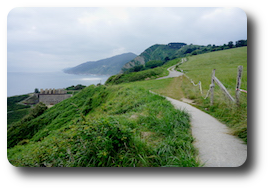 |
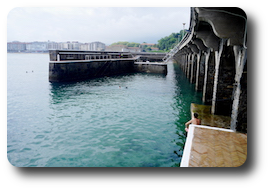 |
It seemed a pity that we were on a mission to achieve our goal on a schedule that allowed little to no time for fun in the sea. But having walked past the beaches of San Sebastian and Zarautz I thought the least we could do was have a swim. Anthony and I debated among ourselves as to whether we could afford some time off for some fun in the water, and soon agreed that we would go for a quick swim at a spot just out of town. It was a good decision - the water was amazingly refreshing. Anthony soon had his first minor injury when he scraped the top of his foot on some sharp rocks. I reminded him how our feet were our number one priority - that we had to take utmost care of our feet if we were to walk the entire 830km. I put some antispetic cream and a plaster on his foot and it healed without any infection within days. |
|
The walk through the Basque countryside was really pleasant as we made our way past vineyards. We saw a few other pilgrims along the way - not many - and that is one of the reasons I like the Northern Way. |
 |
 |
In a town called Getaria we bought some fresh bread, lettuce, tomatoes and jamon for a light and tasty lunch. I love the taste of jamon (Spanish dry-cured ham) and tomatoes that ripen in the sun are better than what I'm used to in cloudy Ireland. We were gradually establishing an eating routine for our camino. |
|
We opted for the coastal option, as did did on most occasions when face with a choice, mainly because we were doing the Northern Camino, also known as the "Coastal" Camino specifiaclly to enjoy the views and cool sea breezes that provide much needed relief on hot days. |
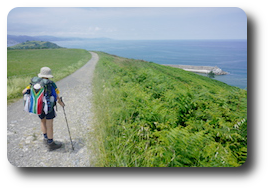 |
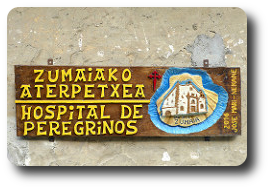 |
Our aim for the day was to reach Deba, which would have been a 23km walk and kept us exactly on target. But shortly after 2pm we reached Zumaia, which is just over halfway, in the stifling heat of the day. There we came a across the most serene sight: Convento San José, an old convent that had been turned into an albergue for pilgrims. The doors had just opened and they were taking in pilgrims for the night. Out of curiosity we looked inside, and saw that we could get a private room with two single beds! After 2 days of camping in our tent this seemed like pure luxury, and the terrace outside with gardens... |
|
We met some Australians and Tania from America who was doing a short section of the camino - something we would often come across: people doing sections of the camino at a time, because not every one is lucky enough to have 5+ weeks leave to do the entire camino in what shot. Why is it that Americans only get 10 or 15 days leave a year? So we decided to take a room and chill for the rest of the day - we can always catch up later and make up for lost time (easier said than done, we would learn in due course...) |
 |
 |
The first town we got to that day was Zarautz, which is well known for its surfing. And rightfully so as the waves that day looked absolutely perfect, and there were at least twenty good surfers out. We too couldn't resist the temptation to get in the sea, so we stopped for a swim.
|
Wed 4 Jul, 17Km (76km)
|
We left the convent fairly early to enjoy the misty morning walk in the hilly countryside. The scenery reminded me of Ireland, or perhaps the Natal midlands back in South Africa during the wet season. The views across green valleys covered in mist were stunning and the weather was perfect: cool but not raining (yet!). |
 |
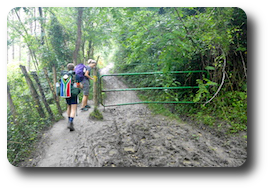 |
It had rained recently and we were glad to be wearing waterproof leather boots with good gripping soles as the mud was thick and slippery in places. The landscape was rural as we walked through farmlands with gates to allow walkers through but block animals. |
|
We often walked through forested areas and along small forest streams as we made our way towards the town called Itziar, which is also a popular name given to Basque women. |
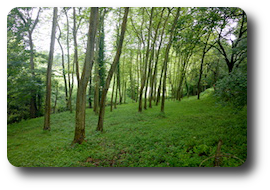 |
 |
In Itziar we stopped for a bread and condensed milk breakfast with fruit, when Anthony bit hard on something to discover that he had lost a tooth! We took our shoes off, as usual, and as Anthony was inspecting his foot where he scraped it while swimming two days earlier, a helpful old pilgrim lady handed him some kind of medicated plaster (I think it was an Ibuprofen plaster?). I'm not sure he really needed it, but we accepted her kind offer. |
|
After a quick visit to the local supermarket for fruit, bread and jamon, we continued on to Deba, which should have been yesterday's destination. And then it came... of first proper rain where we needed to haul out the ponchos to keep dry. |
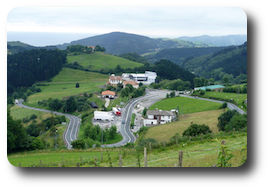 |
 |
I chose ponchos over raincoats as they are light and versatile: they can keep you and your backpack dry without the need for additional backpack rain covers. And I deliberately chose brightly coloured ponchos so that we would be more visible when walking in traffic. But I really don't enjoy walking with a Poncho. It steams up on the inside and starts clinging to your skin. Next time I think I'll try a normal raincaot rather. |
|
The rain didn't persist though, so we were able to liberate ourselves from our ponchos and once again enjoy the green rural scenery. Before long we saw a homemade sign telling us that our destination for the day, Izarbide, was only 50 metres around the corner. |
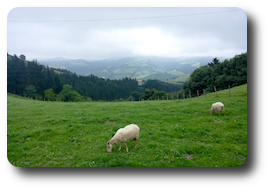 |
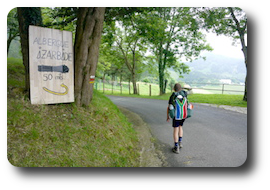 |
Izarbide isn't a town - it's just a place, with an albergue that is also the local bar. It's run by a bunch of busy young people who were quite insistent that things are done just so, eg: no, you mustn't wash your sock here, you have to wash them there. And you must put your backpack here, and your shoes there. And you must select your beds (ladies in one room, gents in the other, though it was seemingly ignored by most). They provided a cooked dinner, though, which was delicious. And we met a small family who were walking part of the camino with their 8 year old son. |
 |
The weather that day was all over the place, starting out cool, then getting warmer and warmer until it started absolutely lashing. One thing we learned about Spanish weather that day was that when it rains, it rains properly - no half hearted drizzle here.
|
Thu 5 Jul, 27Km (103km)
|
We left Izarbide before the crack of dawn, knowing that we had some catching up to do, and also to help establish a habit of starting as early as possible. It was still dark and we needed to use our torches to find our way. I soon realized that it was actually quite pointless walking in the dark - especially when surrounded by views that we were consequently unable to appreciate. |
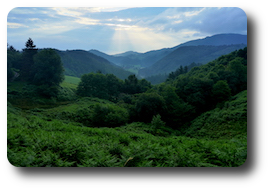 |
 |
Still, it felt good getting an early start, and it wasn't long before the sun rose and we could take in the views of the Basque countryside. The muscles behind Anthony's knee were occasionally hurting, but a bit of Voltaren cream helped sort that out. |
|
The walk though forests was beautiful as we made our way deeper up into the mountains. |
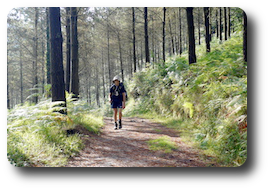 |
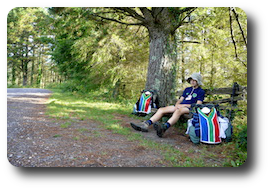 |
It was a long day and we were determined to reach the Monastery at Zenarussa, which would be the first time we cover more than the average daily 23km. |
|
Along mountain contour paths we passed through a variety of forest plantations with occasional views across valleys. |
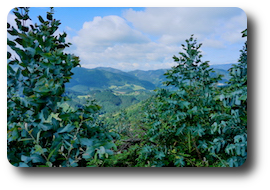 |
 |
We were getting deep into wide open countryside now, with larger farms and farmhouses that seem typical of the Basque region. Before long it started raining, so out came the ponchos, which do a fair enough job up keeping our bodies and backpacks dry, but don't help much when it comes to our boots. |
|
After about 20km+ we were starting to feel tired, but luckily it stopped raining as we made our way up an ancient cobble stone path towards the monastery. When we finally reached the monastery, exhausted, I was surprised to see a pair of pilgrims whom we had met a few days earlier at the convent in Zumaia... My immediate reaction was: how did YOU get here?! |
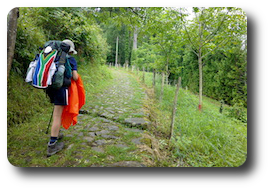 |
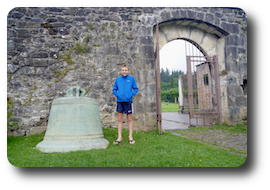 |
I was certain that we had started ahead of them and had made good ground the last two days, covering 44km without either of them passing us along the way. One of them said "we walked here", and I left it there, but a few minutes later she admitted that they had taken a bus or train part of the way... Well, each to their own, I guess. Every person makes their own "camino", and in ancient days some were sent on pilgrimage as punishment or their sins, so they would use whatever means they could find to reach Santiago. But Anthony had told me right from the start that we were going to walk every step of the way... |
|
The monastery itself is really beautiful and we spent a good hour or so exploring the buildings and surrounding gardens. |
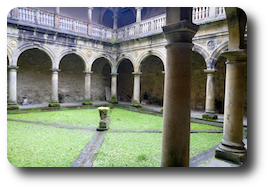 |
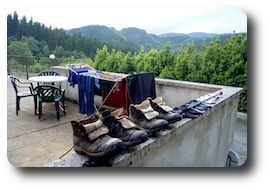 |
This was the first day that we ended with wet boots and socks, which we needed to put out in the (wee bit of) sun to catch the last rays of the day. |
|
I bought a bottle of local craft beer that they make at the monastery, to accompany our dinner later. In the evening the monks carried a large pot full of pasta to the albergue - Anthony's favourite food! He stuffed himself with three helpings before hitting the sack. Today's 27km had been our longest day so far, and we were still behnd schedule, so we set our alarms for another early start the next day... |
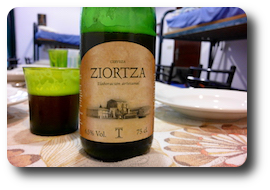 |
 |
Along the way we passed a place selling fresh fruit including paraguayos - a type of flat peach - they were so juicy that we had to lean forewards to avoid all of he juice dripping onto our laps. We had loads of these peaches along the way and they became a common part of our diet.
|
Fri 6 Jul, 28Km (131km)
|
We had set our alarms for 5am for another early start to catch up on our schedule, according to which we were supposed to have reached Guernica already, which was still about 18km ahead. But one grumpy pilgrim would have none of this early rising malarky and sternly told us to put off our lamps. So, we decided to stay in bed another hour - a fightfully easy decision :) |
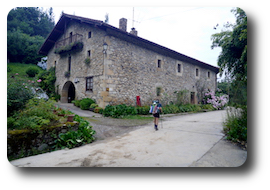 |
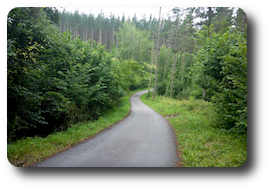 |
The cool, cloudy morning air was perfect and we saw very few people in those early hours. |
|
Having sweated the uphill to the monastery the day before, it was an absolute breeze strolling along the downhill pathways through woodland to Munitibar. |
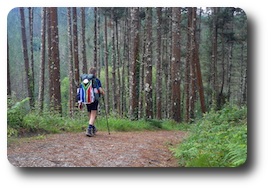 |
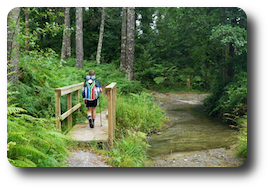 |
As we made our way through Munitibar we came across more and more day hikers, probably also because it was almost weekend. |
|
When we reached Guernica it was lunch time, so we stopped at a town square to take off our still damp shoes and socks and let them air in the sun, while we ate our now routine meal of bread with jamon, cheese, lettuce and tomato, watching the world (and fellow pilgrims) pass by. |
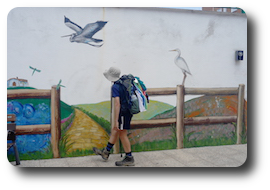 |
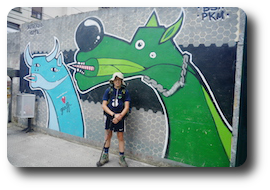 |
Guernica seems like a very artistic town, with lots of street art and sculptures. |
|
Much of the street art is inspired by Picasso's "Guernica" painting depicting the horrors of war, when the town was demolished by German and Italian facist air bombings during the Spanish civil war. |
 |
 |
We didn't have much time on our hands, though, as we popped in at an outdoor shop to buy some extra inner socks after I lost one and developed a hole in another. |
|
Soon we were back in rural Basque countryside, with frequent requests to "shut the gate" as I found myself keeping an eye open in case of randy bulls. |
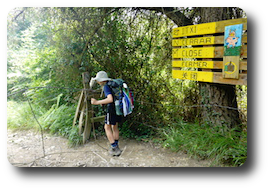 |
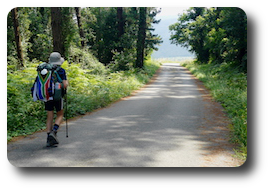 |
The path ahead was flat and long as we aimed to reach Eskerika, which would place us within 7km of our schedule. |
|
The afternoon sunshine was a welcome sight after the wet and damp of the previous few days. |
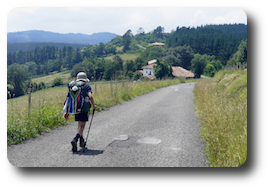 |
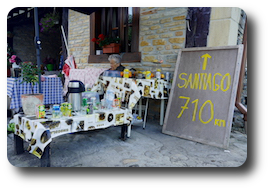 |
Walking beside a forest we were delighted to come across a kind of "lemonade stand" - some entrepeneural locals set up a refreshment station with a sign reminding pilgrims that Santiago was only 710km away... Again we took off our shoes while Anthony sipped a fruit juice and I guzzled down a beer and we both enjoyed some home baked pastries. |
|
The stretch leading to Eskerika was uphill and we started to tire as we were closing in on a new record of 28km... |
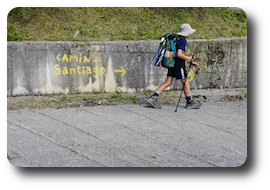 |
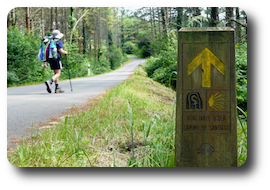 |
We reached a T-junction, with the camino "flechs" (arrows) pointing left, and a small sign pointing to the albergue "only" 280 metres in the opposite direction... those felt like the longest 280 metres I had ever walked! When we finally reached the locked gate of the albergue, it seemed as though no-one was home as our ringing of the bell went unanswered for ages... |
|
Eventually a bloke, the owner, arrived and asked us if we have a booking... |
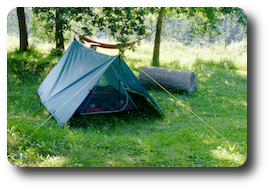 |
After we pitched our tent we played a bit of frisbee. Anthony continued playing on his own as I did our washing and pepared supper. Suddenly he yelled like a piglet being slaughtered as he bashed his shin on a heavy railway sleeper.
I was instantly conflicted between being angry at him for causing unnecesary injury that could derail our camino, and feeling sorry for him. After the obligatory lecture about how our feet (and legs) are the most important things on our camino, I calmed down to pay attention to his injury.
Luckily it wasn't too serious but he was in a bit of pain as fellow pilgrims offered assistance and advice.
And this is how we met John from the USA and Thomas from Germany. John gave us an Ibuprofen tablet - the only one we took the entire trip, though it's apparently a popular pain-killer that some pilgrims consume daily as a precaution. Thomas, who studied some medicine, offered advice on keeping it clean and bandaged to prevent infection. We were to meet John and Thomas at various times along our journey - right up to our final day in Santiago.
It rained softly that night as I slowly dozed off with the gentle comforting sound of rain on the tarp and the clean, fresh country air.
 |
On our way to Eskerika, we passed a small refreshment station with cake, soft drinks and beer. Obviously we paused there to buy somethings from the elderly woman running it. They also had a chalk board that said that we had another 710 kilometers to go until Santiago.
|
Sat 7 Jul, 21Km (152km)
|
Despierta! Despierta! Es tarde ya! The albergue owner shook our tent at 8.30am and told us that we had to leave now. I couldn't believe that we had actually overslept for the first time. But it was a good test to see how quickly we could strike ourtent, pack up and be on the road again. We did it all in under half an hour, and soon we found ourselves slogging through muddy terrain again. |
 |
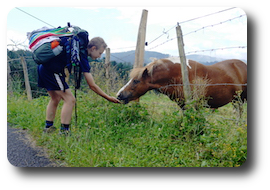 |
One thing that stood out for me the entire camino was the condition of domestic animals. Apart from the occasional equestrian centre, where horses seemed relatively well groomed, all the horses we came across were dirty and covered in flies. Is it just plain neglect - a cultural thing? Or perhaps inevitable due to the prevailing weather conditions? I'm not a "horsey" person, but I felt sorry for the animals that seemed in need of more attentive care. |
|
As we got closer to Bilbao, the political graffiti increased remarkably. It seemed that a particular set of young activists were currently in custody and the painted slogans were calling for their release. Most of the graffiti was in English though instead of Spanish or Euskara, the Basque language that is unique and unrelated to any other European languages. Perhaps deliberately to capture the attention of tourists? |
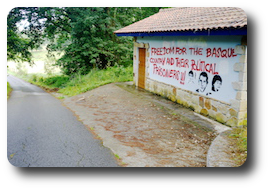 |
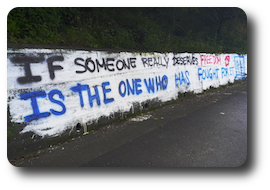 |
Yet the atmosphere was very different from what I felt in Northern Ireland, perhaps because I'm an ignorant foreigner. The Basque people seem to be proud, independent, self-sufficient, with a positive "can do" attitude. And rugby is growing in the region, with the European Champions Cup final being held in Bilbao a few months earlier. |
|
Back to the topic of animals: as we walked up the last uphill approaching Bilbao, we came across a shirtless man taking his pack of dogs for a walk. Among them was a German Shepherd which was struggling to walk - I suspect due to the genetic condition called "hip dysplasia". This was the first time we actually saw a dog owner interacting with his dogs. Well, sort of interacting - he wasn't really engaging with his pets, more like just doing a chore - walking ahead while they follow. |
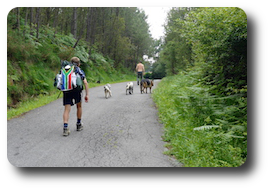 |
But it was better that we would witness all along our journey: dogs that are chained outside, seemingly lonely and often dirty and neglected. It reminded me of cats on farms back in Africa, where they were kept not so much for company, but for the job they did of keeping the mouse and rat populations under control. It seemed that people kept dogs not as companions but for security, ie. to guard their properties.
Before long we reached the top of the hills that overlook Bilbao, and made our way down to the albergue Santa Cruz de Begoña where we were met by a very friendly and helpful hospitalero.
 |
When we were almost at Bilbao, we saw a man walking his dogs, one of which was a german shepard which had a very noticable problem with its heind legs.
|
Sun 8 Jul, 14Km (166km)
|
We hit the almost empty city streets bright & early, walking along the river that runs past the famous Guggenheim museum. |
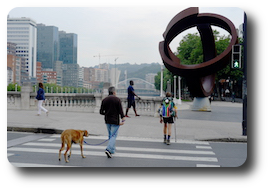 |
 |
I had seen many photos of the museum while planning our trip, but it's really impressive when you see it for real. The early morning sun was catching it occasionally when it peaked through the clouds, and a mist machine was creating a eerie atmosphere outside. |
|
I hadn't planned on actually going inside, being more interested in walking that standing and staring at art exhibitions. Also, the museum doors only opened at 10:30am, which was still more than an hour away... so we hung around outside, eating a light breakfast of fresh fruit and photographing the flower dog scuplture. |
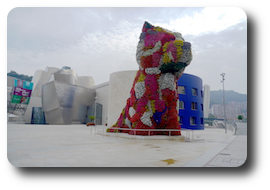 |
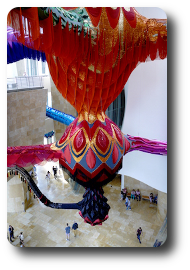 |
Eventually we decided that we would go take a look inside after all, as it isn't every day that one walks past the Guggenheim museum, and we had walked over 150km to get there... Plus, there was a special exhibition of Chagal paintings on display. The entrance hall was impressive, with massive brightly coloured hangings. |
|
The Chagal paintings were really beautiful, and the mazes on the ground floor were an interesting experience, but the remainder of the exhibitions were mostly pretentious modern art nonsense. |
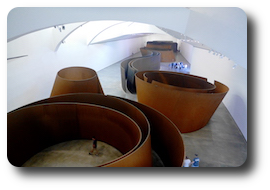 |
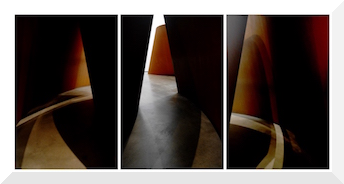 |
We weren't allowed to photograph the exhibitions, but I did sneak a few shots of the mazes on the ground floor. |
|
It was almost 2pm by the time we stepped outside into bright sunlight and streets packed with tourists. |
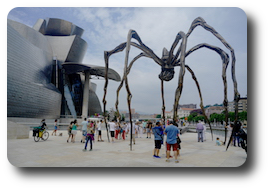 |
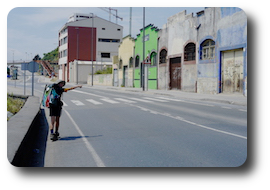 |
And then came the hard part: walking past old industrial areas on tarmac during the heat of the day... |
|
It was really tough and Anthony was struggling a bit with his knee again, so out came the trusty Voltaren cream. |
 |
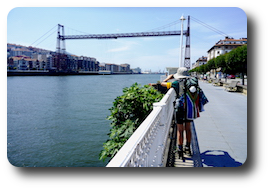 |
We kept a keen eye open for the first sighting of the famous "hanging" bridge that we were to cross at Portugalete. |
|
After crossing the bridge and making our way up the sidewalk escalators, couldn't find the municipal albergue. A friendly local helped us out by escorting us back towards the bridge, where we found the albergue right beside the bridge we just crossed slightly earlier. After checking in and doing our daily washing, it was a relief to liberate our hot feet from our boots. |
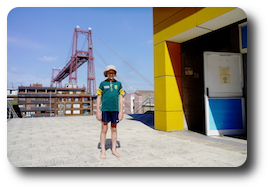 |
We wandered around looking for a supermarket to buy food, but it was a Sunday afternoon and most places were closed. Eventually we decided to just grab a take-away pizza and drinks (a large beer plus Mountain Dew for only €2.25!) which we took back and ate at the albergue.
 |
One of the first things we did that day was to go to the Guggenheim Museum which is one of the most famous museums on Earth. To be honest, other than a few interesting pieces on the top floor, it was a bit underwhelming.
|
Mon 9 Jul, 28Km (194km)
2.30 in the morning and 2 complete assholes get out of bed and start talking loudly with absolutely no consideration for the hall full of tired sleepers... I let out a loud and irritable SSSHHH!!! which seemed to (surprisingly) do the trick as they quietened down and left. Bloody Italians!
|
The walk out of the urban area was lined with graffiti as we trailed behind a couple in their sixties who we were to meet a few times along our way. They were doing their 13th camino! |
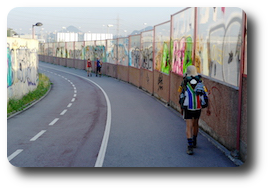 |
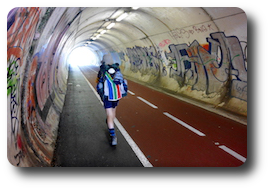 |
The morning air was crisp and bright as we were in for some sunny weather that day. |
|
We passed a seemingly popular swimming beach at Pobeña, but it was too early to stop for a swim and I was afraid we might lose too much time if we did. |
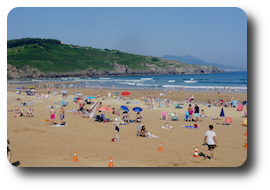 |
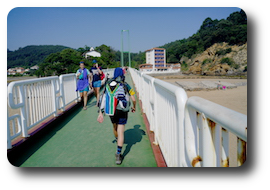 |
So we continued across a foot bridge into more scenic territory - a welcome sight after a few days of hard walking through urban and industrial areas. |
|
The path hugged the coast with wind swept trees as the summer sun was getting higher and the temperature rose into the 30's. |
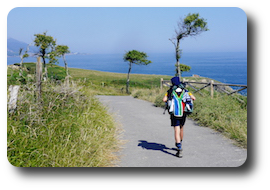 |
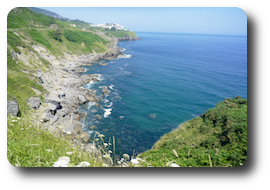 |
Soon we crossed into the province of Cantabria, leaving the Basque region behind. The cool blue waters of the Atlantic were becoming increasingly inviting... |
|
Shortly before the path swung back inland before Ontón we stopped for a breather and a few peaches not far from a pebble beach. Knowing that we wanted to reach Castro-Urdiales that day, I made some quick mental calculations to work out if we could afford a swim, and then we decided that a quick swim would defintely be worth it. |
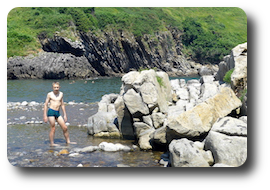 |
 |
After our swim we needed to speed up through Ontón and on to Miñon where we stopped for a lunch of "pintxos" (tapas) at a bar with a Simpsons theme. There we met an American mother and son whom we met briefly a few days earlier. |
|
We decided to head to Castro-Urdiales with our American friends, again encountering graffiti on our way into built-up urban areas. |
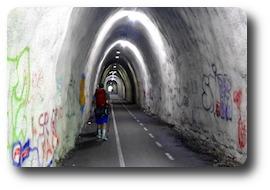 |
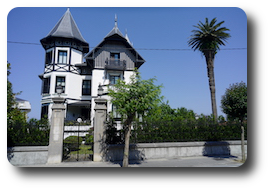 |
Our feet were tiring as we walked the suburbs, which seemed quite neat & tidy. We almost got lost a few times as we made our way to the small albergue on the other end of town. |
|
After a gruelling last hour of walking we finally reached the albergue, only to find it fully occupied as it only has 16 beds. Our American compadres decided to book a B&B online, while we asked if we could pitch our tent in the garden. The friendly, helpful hospitalero said it's fine and charged us only €3 for our tent 😀 |
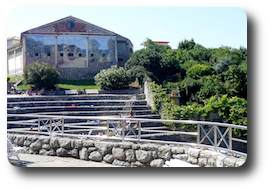 |
After we had pitched our tent we headed straight for the beach for a swim - our second that hot sunny day.
With a packed and overflowing albergue, and having walked 28km that day, we decided not to cook dinner. Instead, we did our washing and headed over to a restaurant that we saw earlier along the way advertising a "pilgrim's menu". So, for €11 each we enjoyed a 2-course dinner: a salad starter followed by a main dish - Anthony chose pasta with meatballs and I had fish and chips, plus the customary beer and coke.
 |
On the way to Castro-Urdiales, there is a path split and just before it there is a rocky beach with beatifully clear water where we decided to cool down for a bit.
|
Tue 10 Jul, 24Km (218km)
Saturnino Candina
|
|
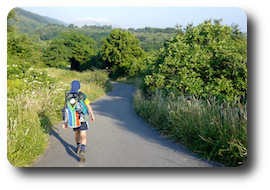 |
|
|
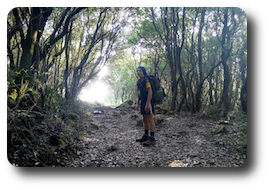 |
|
|
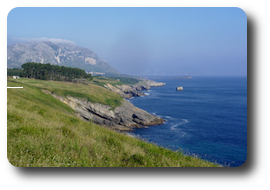 |
|
|
 |
|
|
 |
|
|
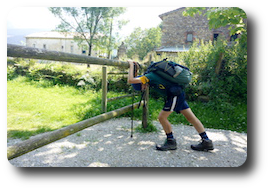 |
|
|
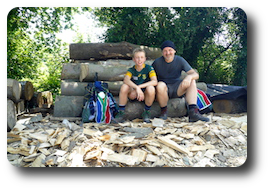 |
|
|
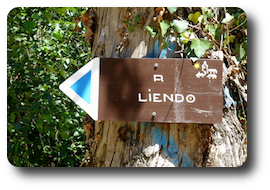 |
|
|
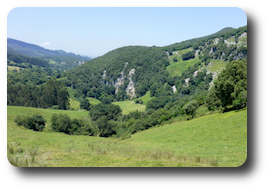 |
|
|
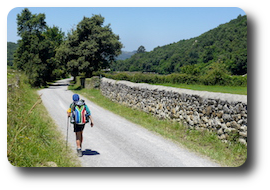 |
|
|
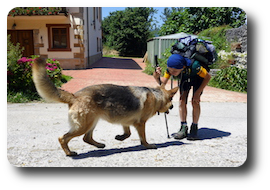 |
|
|
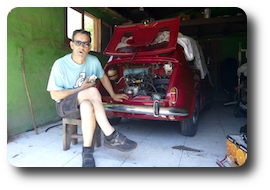 |
|
|
 |
|
|
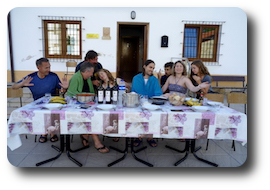 |
 |
At the albergue, just about everybody came together to make a communal meal of pasta with suace. It was another great example of the "Camino spirit." Before we ate, we took a picture of everyone posing in positions like the last supper. When we were done, we left the leftovers in the fridge for the next day's peregrinos
|
Wed 11 Jul, 21Km (239km)
Hotel Los Nogales
|
|
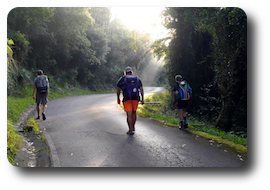 |
|
|
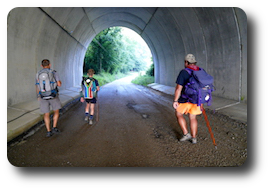 |
|
|
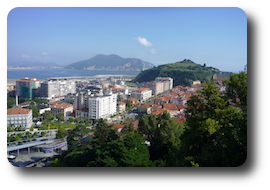 |
|
|
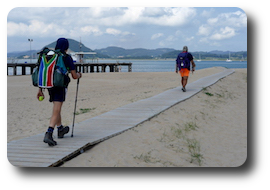 |
|
|
 |
|
|
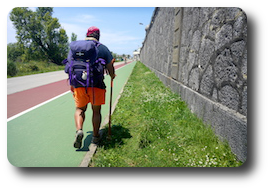 |
|
|
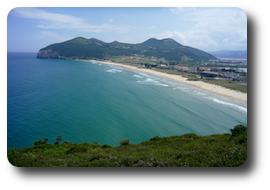 |
|
|
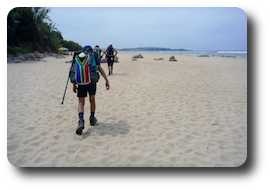 |
 |
The night before, we stayed in the same albergue as a few people we had met along the way like Sean and Arthur. We ended up walking with both of them that day and had to say goodbye to Arthur. A lot of the time on the camino we were making friends and saying goodbye to others.
|
Thu 12 Jul, 15Km (254km)
|
|
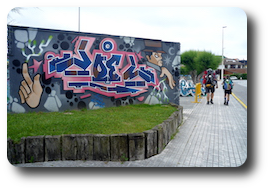 |
|
|
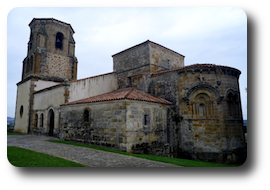 |
|
|
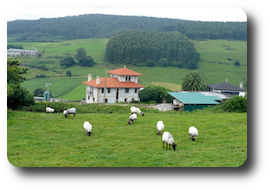 |
|
|
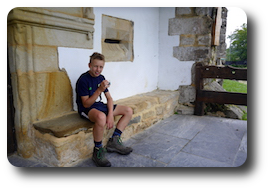 |
|
|
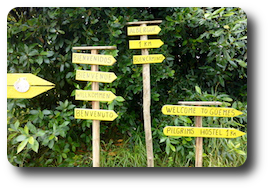 |
|
|
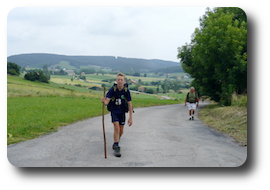 |
|
|
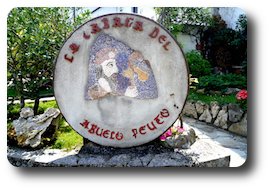 |
|
|
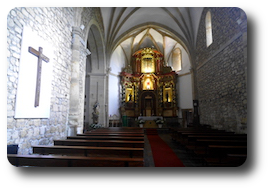 |
|
|
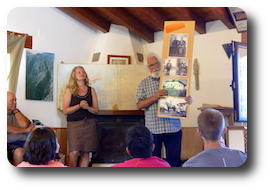 |
La Cabaña del Abuelo Peuto
 |
The albergue in which we stayed in Güemes was a very well known "donativo" run by a man in his eighties. It was a very comfortable night and almost everyone we had met along the way was there. They did breakfast, lunch and dinner and while we were too late for lunch, the dinner and breakfast were both delicious.
|
Fri 13 Jul, 15Km (269km)
|
|
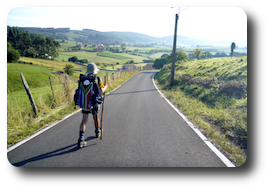 |
|
|
 |
|
|
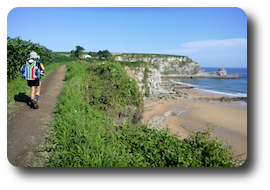 |
|
|
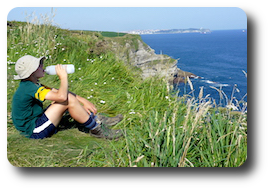 |
|
|
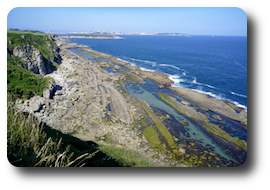 |
|
|
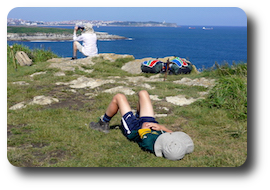 |
|
|
 |
|
|
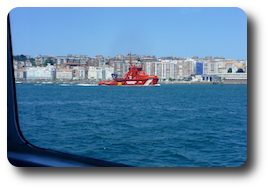 |
Santos Mártires
 |
There are two routes to Santander, there is a shorter tar road and a more scenic route that's longer by only three kilometers. We took the longer of the two and it was certainly worth it for the amazing views.
|
Sat 14 Jul, 18Km (287km)
|
|
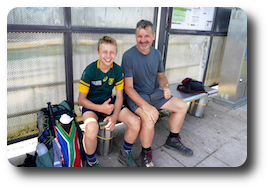 |
|
|
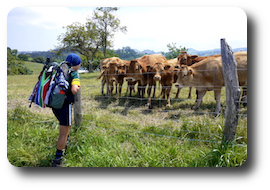 |
|
|
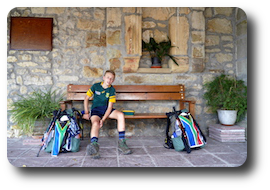 |
|
|
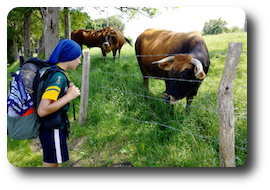 |
|
|
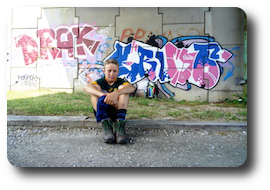 |
|
|
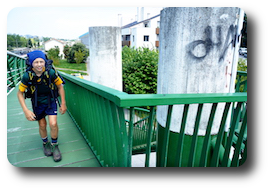 |
Clara Campoamor
 |
We took an alternate route through a small town in which there was a lot of cattle and most herds were quite curious of us and came close to the gate. One herd, all of the cows in which had big horns came a bit too close for comfort and we ran half way through the town to get away from them.
|
Sun 15 Jul, 22Km (309km)
|
|
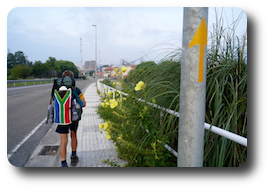 |
|
|
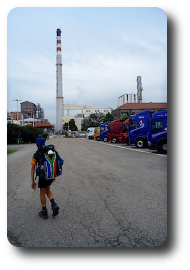 |
|
|
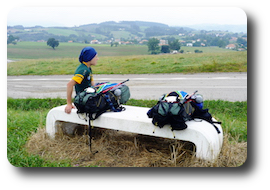 |
|
|
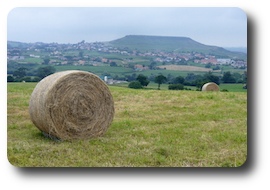 |
|
|
 |
|
|
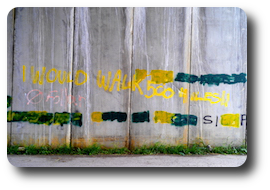 |
|
|
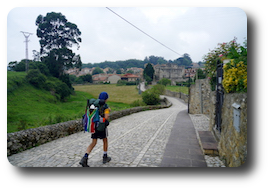 |
|
|
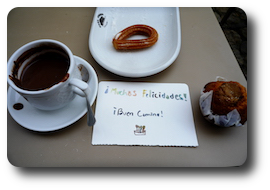 |
|
|
 |
|
|
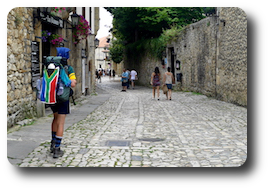 |
|
|
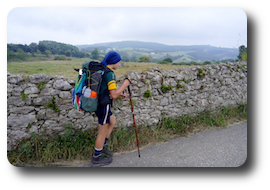 |
|
|
 |
|
|
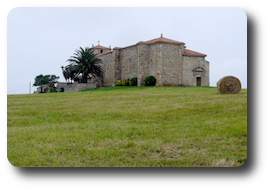 |
|
|
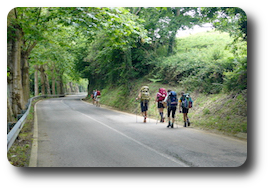 |
El Pino
 |
Along the way we saw some people we had met before, while walking through a small town. The architecture in the town, especially the church, was amazing and there were many people taking photos of it.
|
Mon 16 Jul, 30Km (339km)
|
|
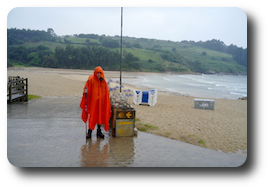 |
|
|
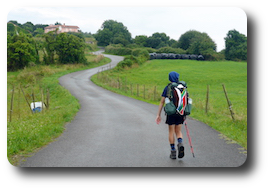 |
|
|
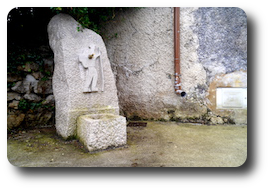 |
|
|
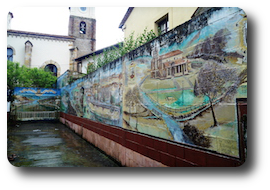 |
|
|
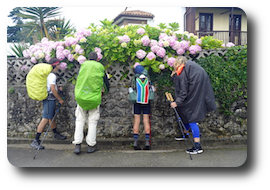 |
|
|
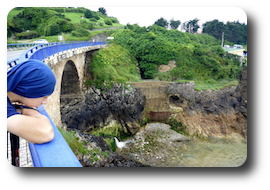 |
|
|
 |
|
|
 |
|
|
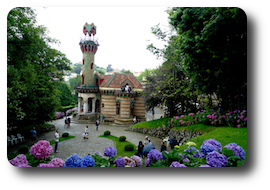 |
|
|
 |
|
|
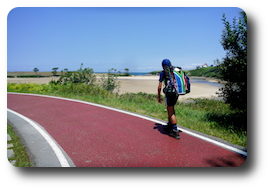 |
|
|
 |
|
|
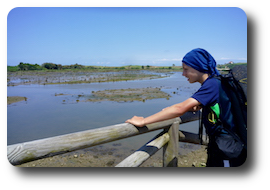 |
|
|
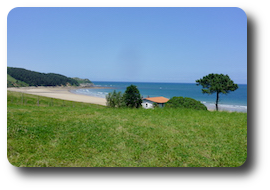 |
|
|
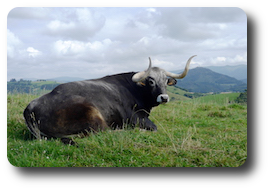 |
|
|
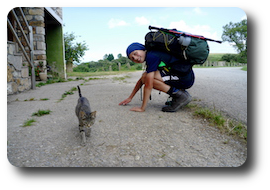 |
|
|
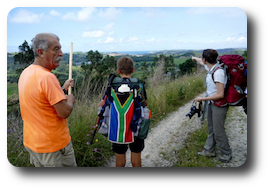 |
|
|
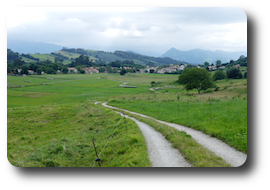 |
|
|
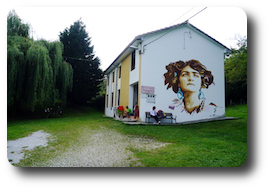 |
|
|
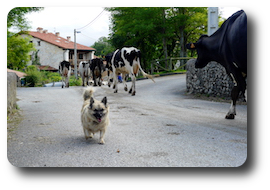 |
|
|
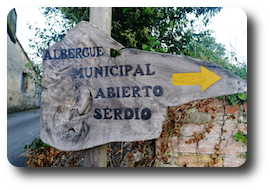 |
Municipal
 |
We visited a building called El Capricho de Gaudi which is the only building designed by Gaudi outside of Cataluña. The house is designed to soak up as much light as possibe like a sunflower.
|
Tue 17 Jul, 35Km (374km)
|
|
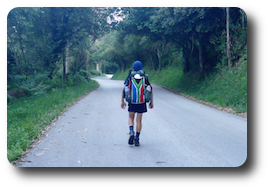 |
|
|
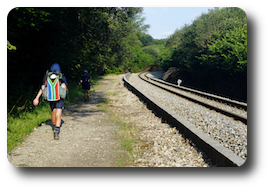 |
|
|
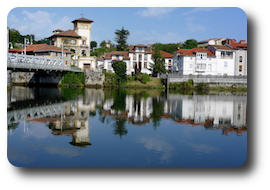 |
|
|
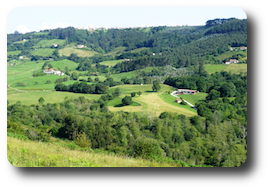 |
|
|
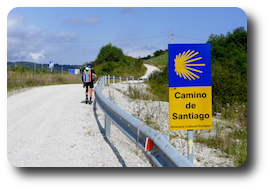 |
|
|
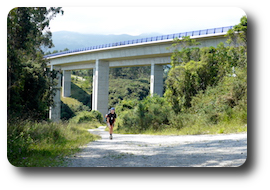 |
|
|
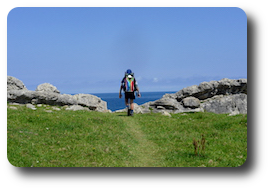 |
|
|
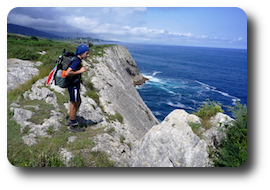 |
|
|
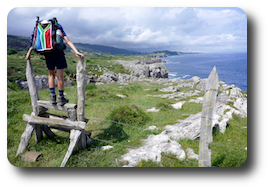 |
|
|
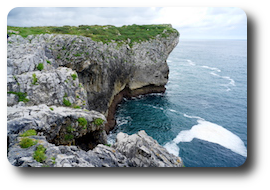 |
|
|
 |
|
|
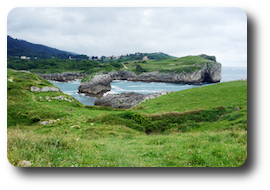 |
|
|
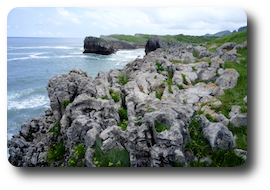 |
|
|
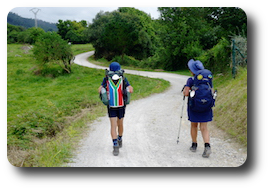 |
|
|
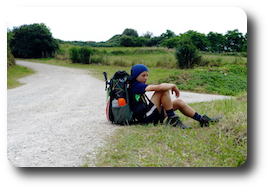 |
|
|
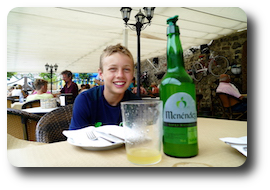 |
|
|
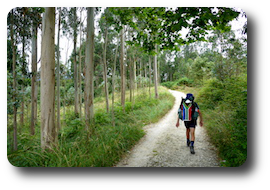 |
|
|
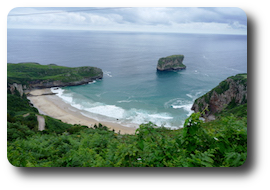 |
|
|
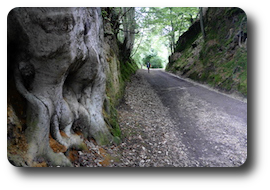 |
Senda del Peregrino
 |
Along the Asturias coastline, where we walked that day, there is a blowhole that shoots water incredibly high. Unfortunately, it was low tide when we arrived so we didn't get to see the water, but we could still hear the loud bellows and feel the rush of air.
|
Wed 18 Jul, 24Km (398km)
|
|
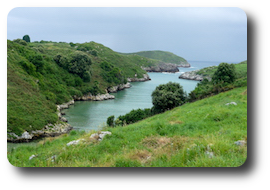 |
|
|
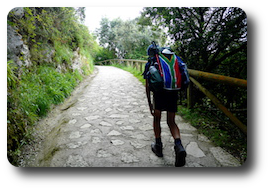 |
|
|
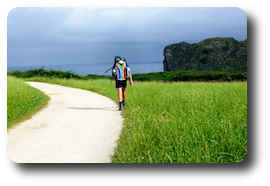 |
|
|
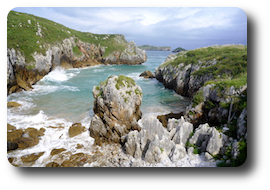 |
|
|
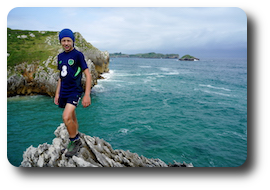 |
|
|
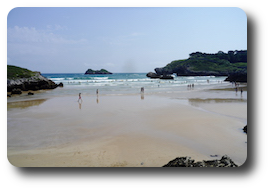 |
|
|
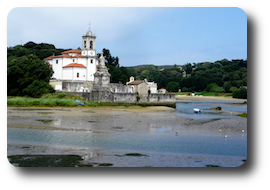 |
|
|
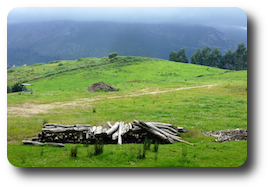 |
|
|
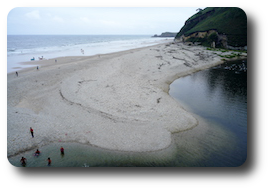 |
|
|
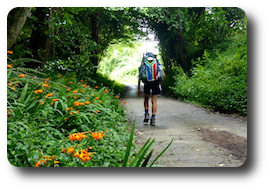 |
|
|
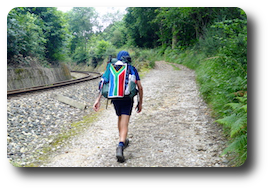 |
|
|
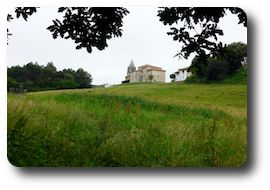 |
|
|
 |
|
|
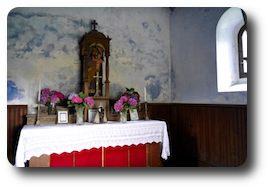 |
|
|
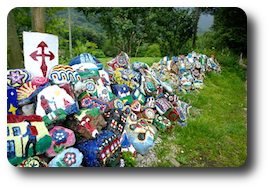 |
|
|
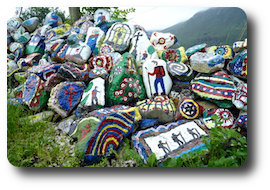 |
|
|
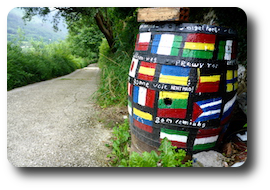 |
|
|
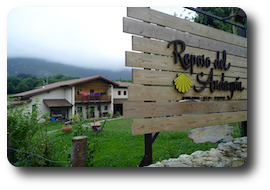 |
Reposo del Andayón
 |
On the last stretch to the albergue, we walked along a small stone wall with little paintings related to the camino on the stones, for example: shells, backpacks and pilgrims.
|
Thu 19 Jul, 13Km (411km)
|
|
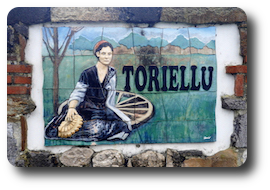 |
|
|
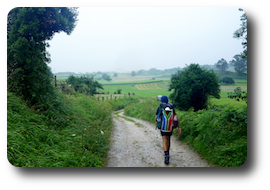 |
|
|
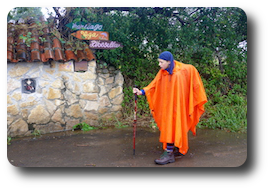 |
|
|
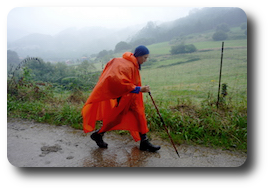 |
|
|
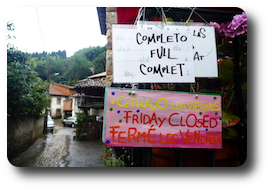 |
|
|
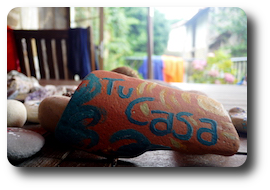 |
|
|
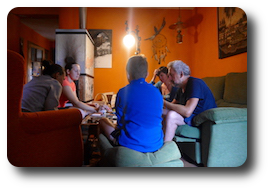 |
|
|
 |
|
|
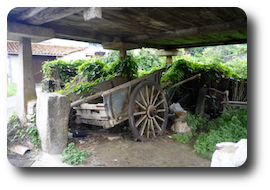 |
|
|
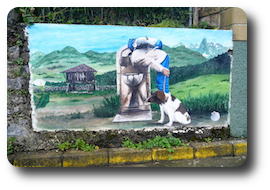 |
|
|
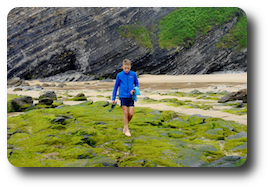 |
|
|
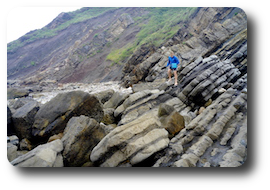 |
|
|
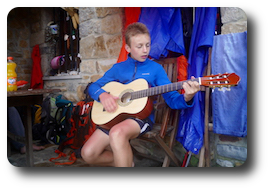 |
|
|
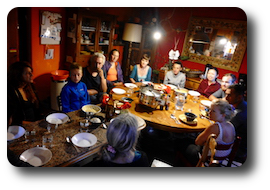 |
Tu Casa
 |
We arrived at a full albergue in the pouring rain. As with previous occasions when we were allowed to pitch our tent in the garden, we again experienced the "Camino Spirit" when the hospitalero arranged alternative accomodation at a nearby friend's house.
|
Fri 20 Jul, 25Km (436km)
|
|
 |
|
|
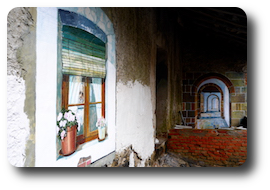 |
|
|
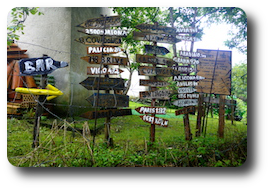 |
|
|
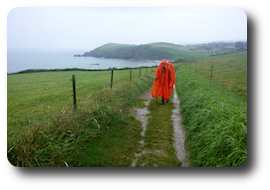 |
|
|
 |
|
|
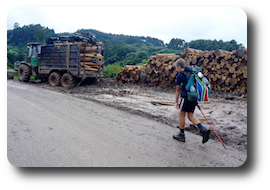 |
|
|
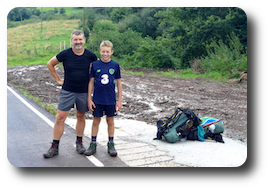 |
|
|
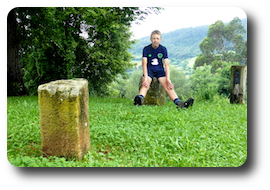 |
|
|
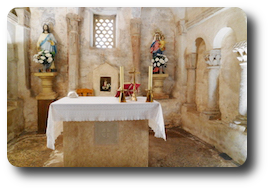 |
|
|
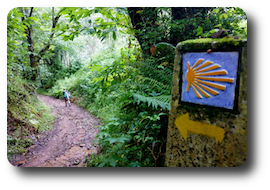 |
|
|
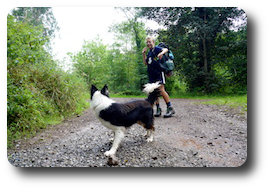 |
|
|
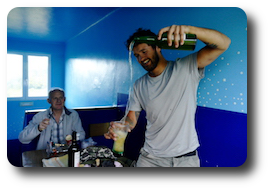 |
Municipal
 |
The markings that day were hard to follow, especially in and out of towns, but the local people were very happy to help us find our way back to the path - yet another example of the "Camino Spirit" on the way.
|
Sat 21 Jul, 28Km (464km)
|
|
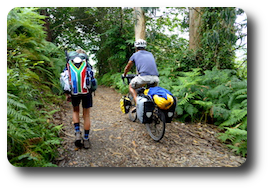 |
|
|
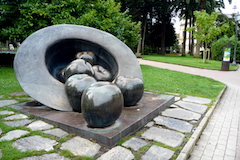 |
|
|
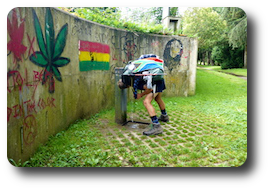 |
|
|
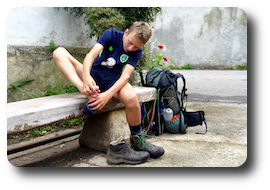 |
|
|
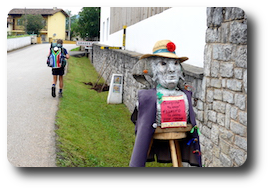 |
|
|
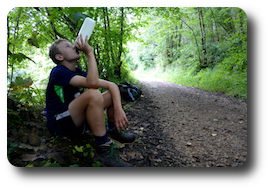 |
|
|
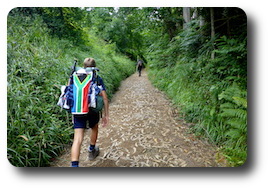 |
|
|
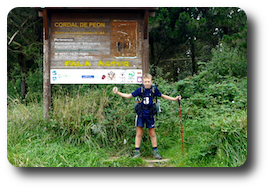 |
|
|
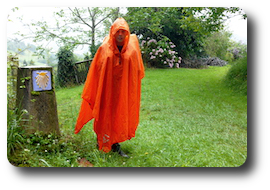 |
|
|
 |
|
|
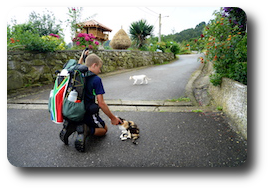 |
|
|
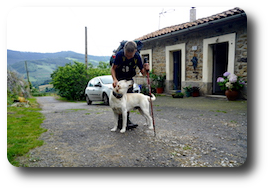 |
Camping Deva
 |
One of the mountains we walked up today, called Alto de Cruz, gave us amazing views of the snow-covered Picos de Europa in the distance. Some more adventurous pilgrims veer off the French way to experience the rough beauty of this mountain range.
|
Sun 22 Jul, 33Km (497km)
|
|
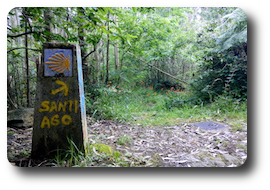 |
|
|
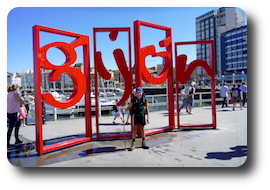 |
|
|
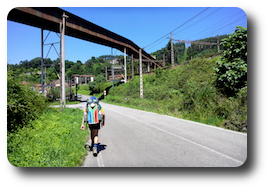 |
|
|
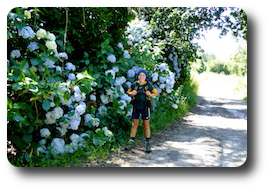 |
|
|
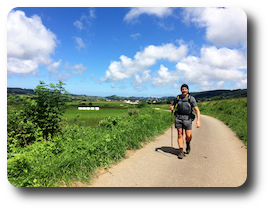 |
|
|
 |
|
|
 |
|
|
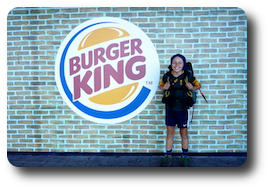 |
Pedro Solís
 |
We walked through quite an ugly industrial area, which our guide book even recommended taking a bus or taxi to avoid it if necessary.
But we stayed true to the promise we had made at the start of the Camino to walk every step of the way,
and I'm glad that we did because experiencing boring or less attractive areas helped us to appreciate the beautiful areas even more.
|
Mon 23 Jul, 23Km (520km)
|
|
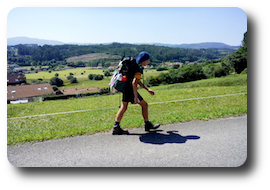 |
|
|
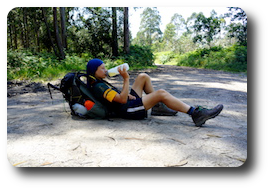 |
|
|
 |
|
|
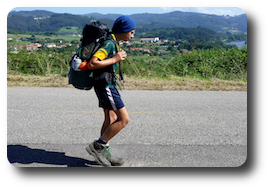 |
|
|
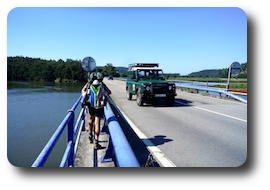 |
|
|
 |
|
|
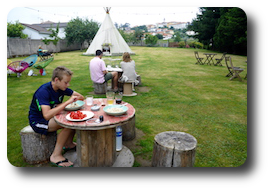 |
Casa Carmina
 |
I developed a sore throat - the first time I felt ill after walking more than 500km over 23 days without any rest days - but I was still able to keep on going and reach our destination for the day. While at the albergue, a nurse who was walking the way as well told us that it wasn't anything serious and that I would be back to normal soon.
|
Tue 24 Jul, 0Km (520km)
REST
Wed 25 Jul, 16Km (536km)
|
|
 |
|
|
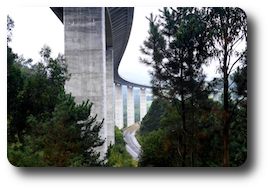 |
|
|
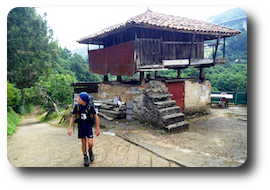 |
|
|
 |
|
|
 |
|
|
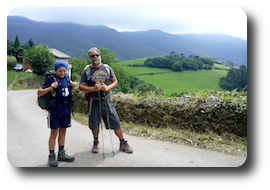 |
Municipal
 |
After taking a rest the day before, and with me recovering, we took it slower and instead of focusing on trying to get as far as possible, we paid more attention to the beautiful countryside scenery.
|
Thu 26 Jul, 19Km (555km)
|
|
 |
|
|
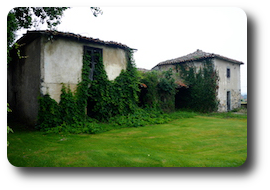 |
|
|
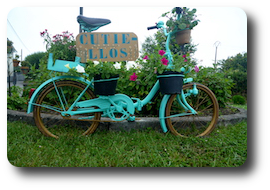 |
|
|
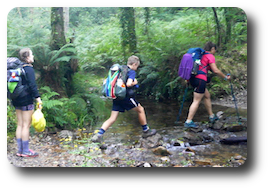 |
|
|
 |
|
|
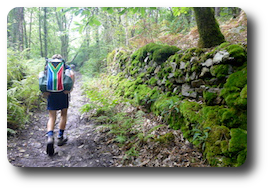 |
|
|
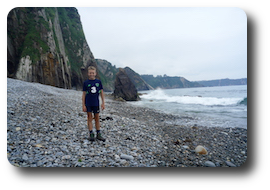 |
|
|
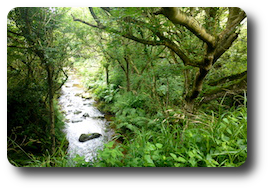 |
|
|
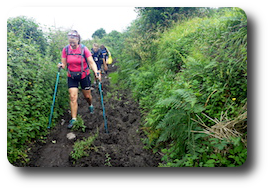 |
|
|
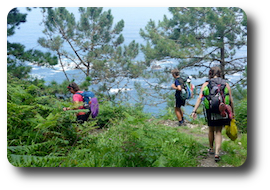 |
Apartamentos Casa Carin
 |
Today we stopped for a brief detour at a beach full of round rocks and stones and no sand, which I thought was pretty cool even though we decided not to go for a swim like we normally would.
|
Fri 27 Jul, 32Km (587km)
|
|
 |
|
|
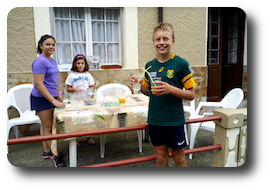 |
|
|
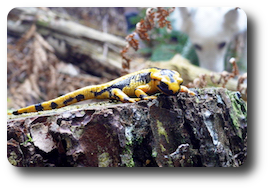 |
|
|
 |
|
|
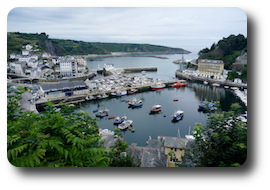 |
|
|
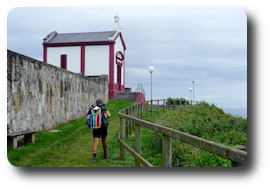 |
|
|
 |
|
|
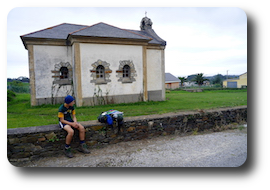 |
|
|
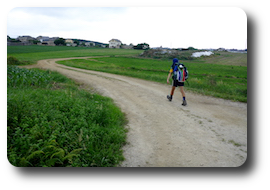 |
|
|
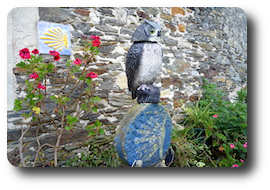 |
|
|
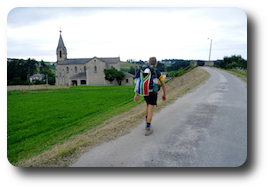 |
Municipal
 |
In a forest we came across a black and yellow salamander that stood completely motionless as if posing for everyone to photograph it.
|
Sat 28 Jul, 26Km (613km)
|
|
 |
|
|
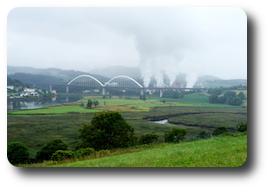 |
|
|
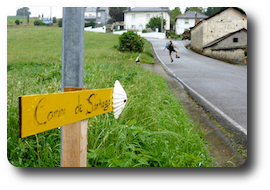 |
|
|
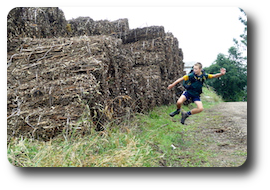 |
|
|
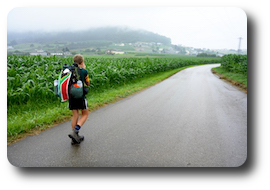 |
|
|
 |
|
|
 |
|
|
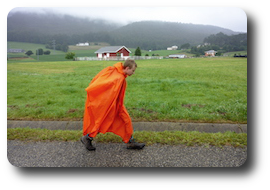 |
|
|
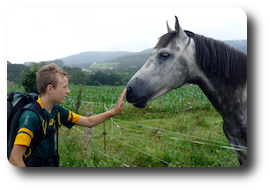 |
|
|
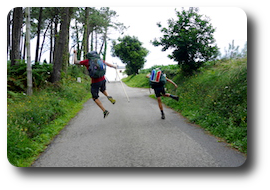 |
|
|
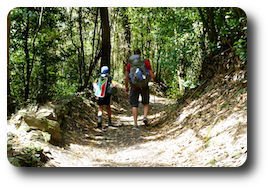 |
|
|
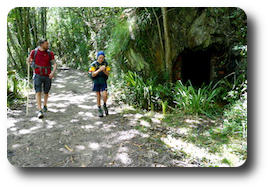 |
|
|
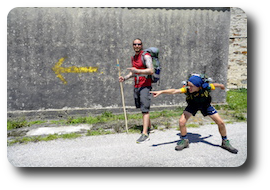 |
|
|
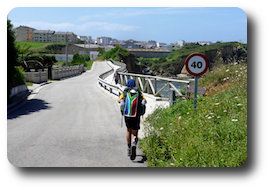 |
|
|
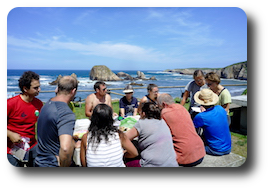 |
|
|
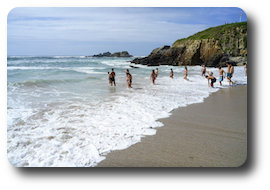 |
|
|
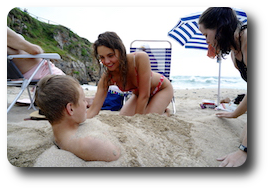 |
|
|
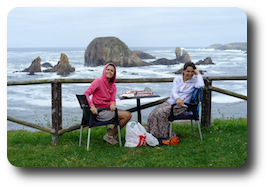 |
|
|
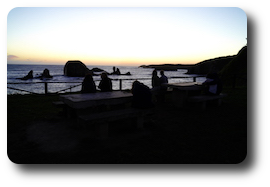 |
Municipal
 |
Today was our last day by the sea, so we made the most of it by spending almost two hours at the beach, where we swam in spite of the waves that were so rough due to the steep incline.
|
Sun 29 Jul, 34Km (647km)
|
|
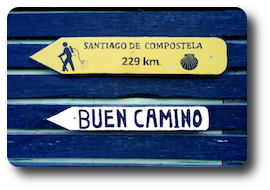 |
|
|
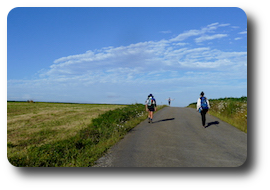 |
|
|
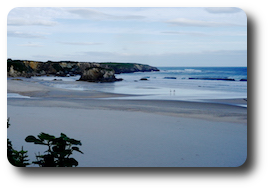 |
|
|
 |
|
|
 |
|
|
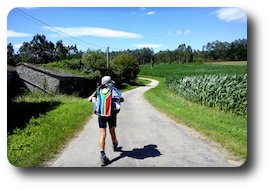 |
|
|
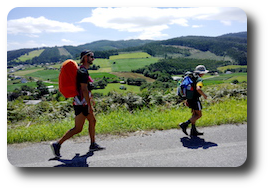 |
|
|
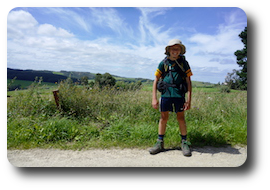 |
|
|
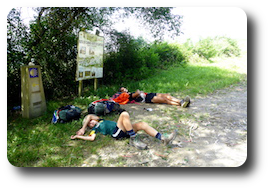 |
|
|
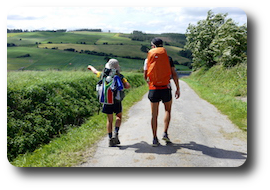 |
|
|
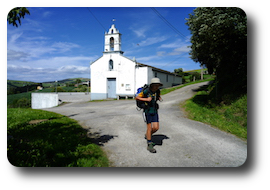 |
|
|
 |
|
|
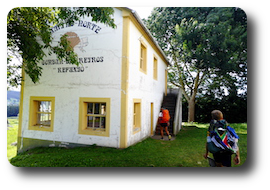 |
Municipal
 |
Our first day in Galicia was a lot tougher than what we experienced in Asturias, because we needed to make up for lost time after our rest day by walking more than 30km per day. It was especially tough due to the elevation to which we climbed along mountain ranges.
|
Mon 30 Jul, 34Km (681km)
|
|
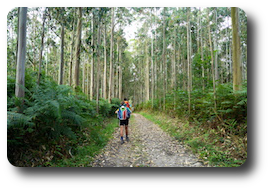 |
|
|
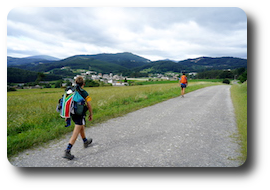 |
|
|
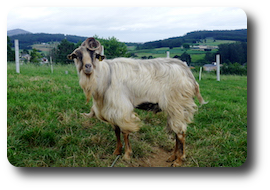 |
|
|
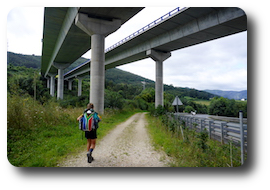 |
|
|
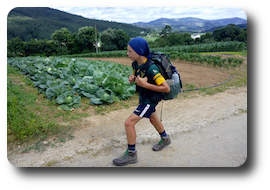 |
|
|
 |
|
|
 |
|
|
 |
|
|
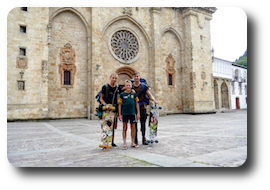 |
|
|
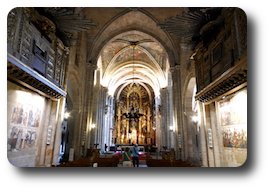 |
|
|
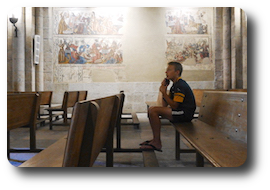 |
|
|
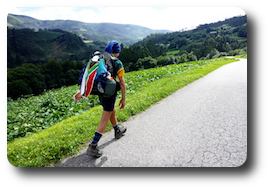 |
|
|
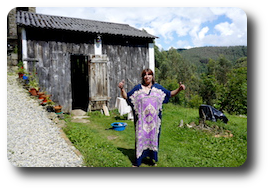 |
|
|
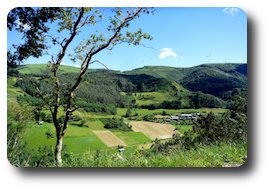 |
|
|
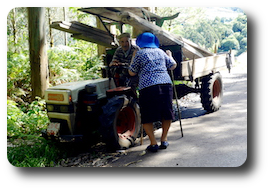 |
|
|
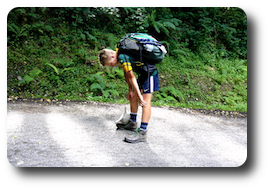 |
|
|
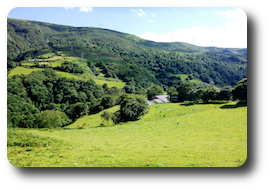 |
|
|
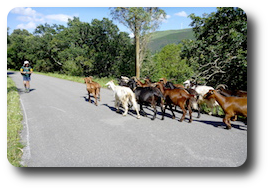 |
|
|
 |
|
|
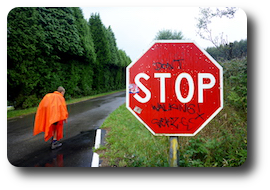 |
|
|
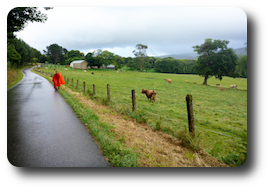 |
Xunta
 |
We stopped in Mondoñedo for lunch and took a break to look inside the church. Before we went inside, we saw two Dutch guys who were doing the Camino with skate boards.
|
Tue 31 Jul, 21Km (702km)
|
|
 |
|
|
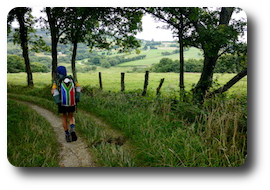 |
|
|
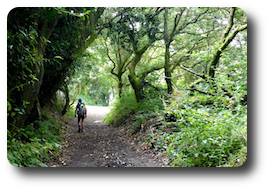 |
|
|
 |
|
|
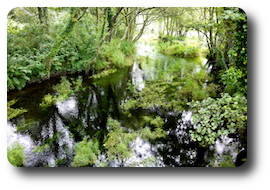 |
|
|
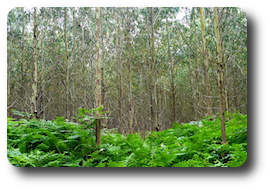 |
|
|
 |
|
|
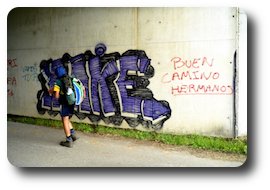 |
|
|
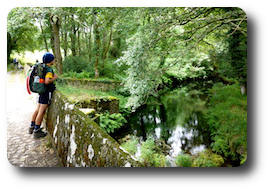 |
|
|
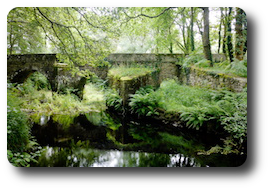 |
|
|
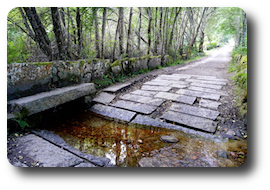 |
|
|
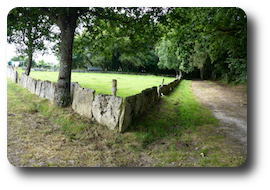 |
|
|
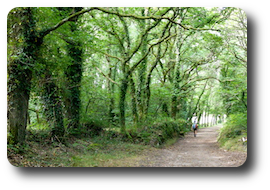 |
|
|
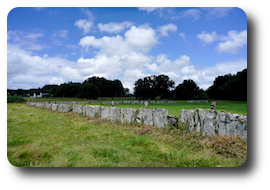 |
|
|
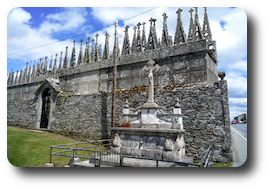 |
|
|
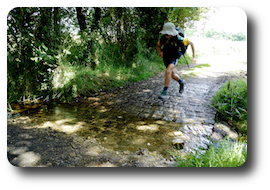 |
|
|
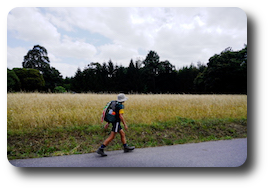 |
|
|
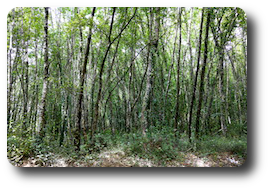 |
|
|
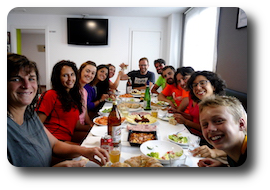 |
Castelos
 |
We were walking through the countryside when we saw some fields divided up by flat stone walls, similar to the ancient hedges we saw in county Clare in Ireland a few years ago when we walked along the Cliffs of Moher.
|
Wed 1 Aug, 19Km (721km)
|
|
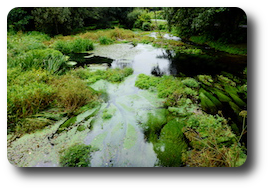 |
|
|
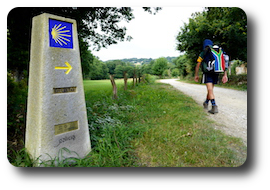 |
|
|
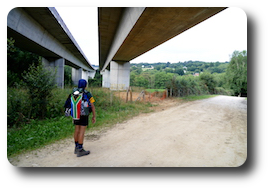 |
|
|
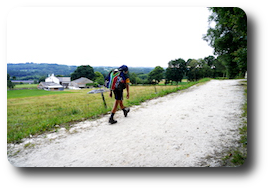 |
|
|
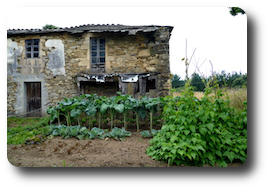 |
|
|
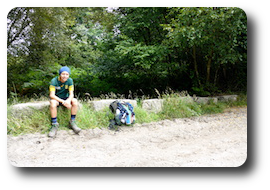 |
|
|
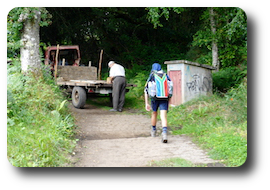 |
|
|
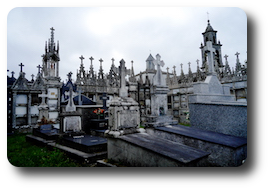 |
|
|
 |
|
|
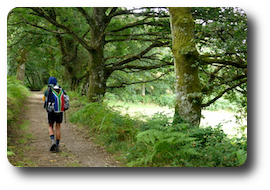 |
|
|
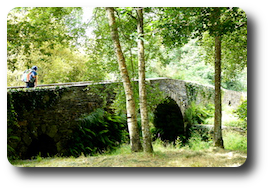 |
|
|
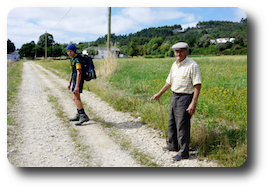 |
|
|
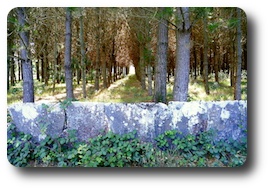 |
|
|
 |
|
|
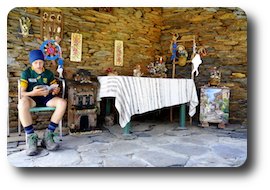 |
|
|
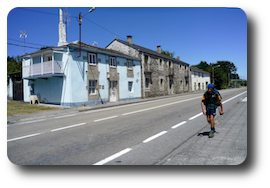 |
|
|
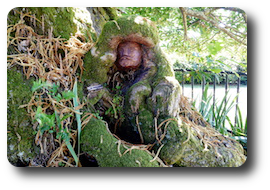 |
Xunta
 |
Just around the corner from the Albergue there is a church with a tree in the gardens that was going to be cut down, but an artist protested by carving the inside of the tree into beautiful sculptures.
|
Thu 2 Aug, 15Km (736km)
|
|
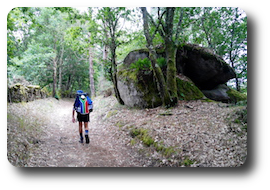 |
|
|
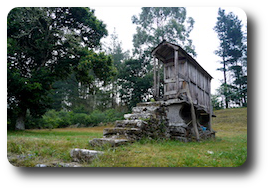 |
|
|
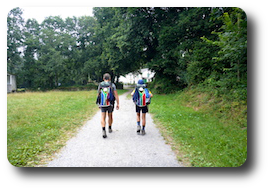 |
|
|
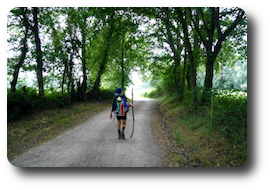 |
|
|
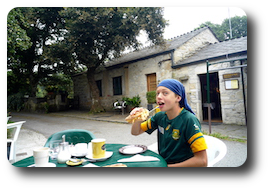 |
|
|
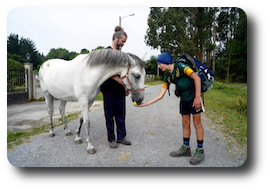 |
|
|
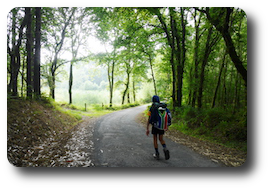 |
|
|
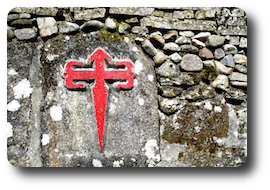 |
|
|
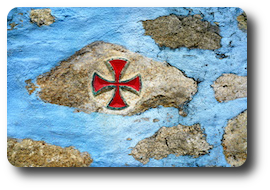 |
|
|
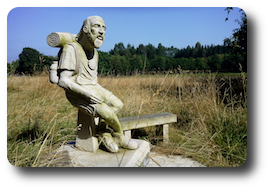 |
|
|
 |
ó Abrigo
 |
We stopped shortly at a place where an old man was doing authentic wax stamps for peregrinos, and everyone seemed to stop there to get their credentials stamped by him.
|
Fri 3 Aug, 25Km (761km)
|
|
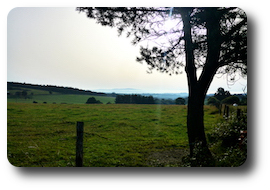 |
|
|
 |
|
|
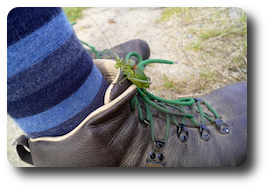 |
|
|
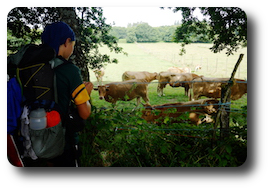 |
|
|
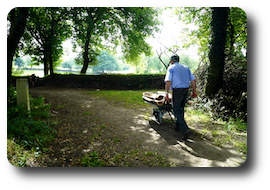 |
|
|
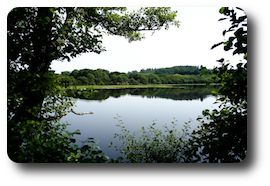 |
|
|
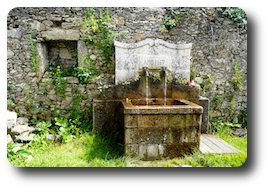 |
|
|
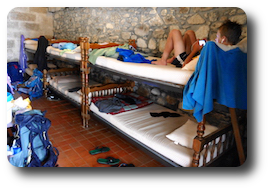 |
|
|
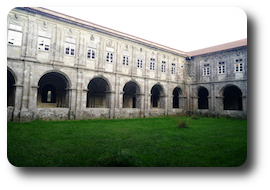 |
|
|
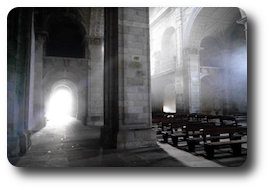 |
|
|
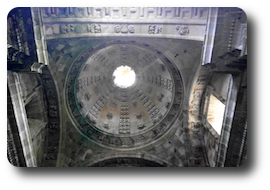 |
|
|
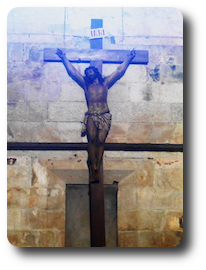 |
|
|
 |
|
|
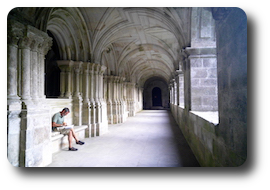 |
|
|
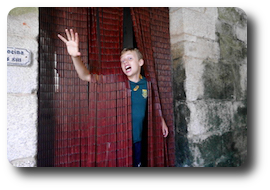 |
Albergue de peregrinos
 |
Along the way, we kept on making new friends and saying goodbye to others. That day we met up with many people who we had walked with before, and caught up with again. Many of them seemed to congregate at this place to see and experience to monastery.
|
Sat 4 Aug, 22Km (783km)
|
|
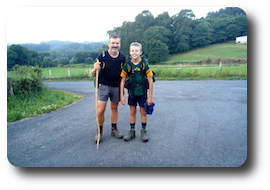 |
|
|
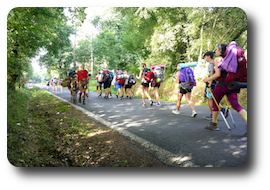 |
|
|
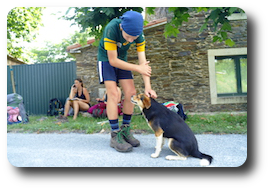 |
|
|
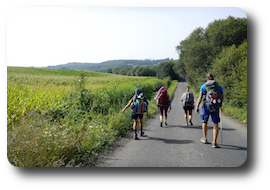 |
|
|
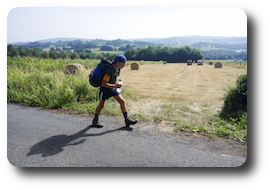 |
|
|
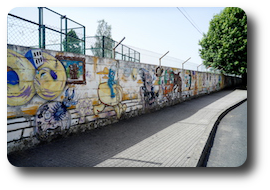 |
|
|
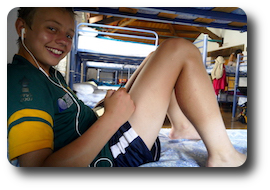 |
|
|
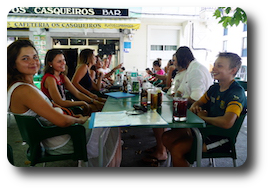 |
Xunta
 |
Today we joined up with pilgrims from the french way and the primitivo. Because there were so many people on the road, we weren't able to enjoy as much of the surrounding scenery. With the swarms of people surrounding us, the noise of chattering casual pilgrims was quite different from the quiet environment that we remember walking along the coast.
|
Sun 5 Aug, 19Km (802km)
|
|
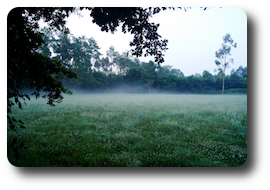 |
|
|
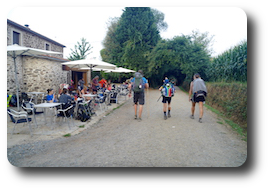 |
|
|
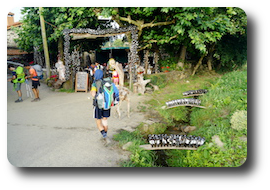 |
|
|
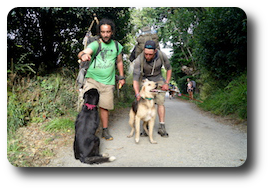 |
|
|
 |
|
|
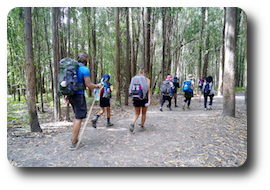 |
|
|
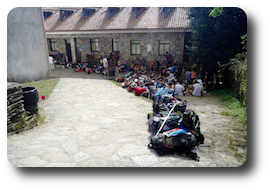 |
|
|
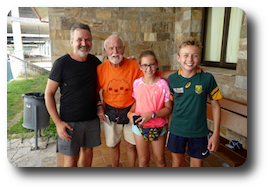 |
|
|
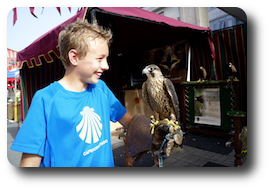 |
Xunta
 |
At the albergue, we met an old man in his seventees who was doing the camino with his nine year old granddaughter, Even though they were only walking the minimum 100 km required to get their Compostella in Santiago, I still thought it was impressive that they were doing it.
|
Mon 6 Aug, 20Km (822km)
|
|
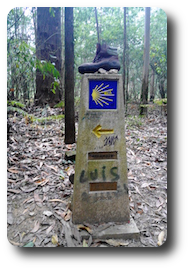 |
|
|
 |
|
|
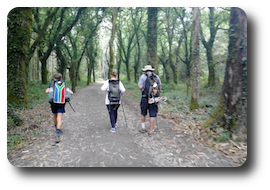 |
|
|
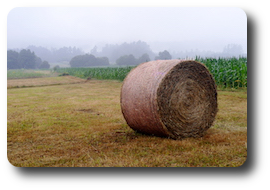 |
|
|
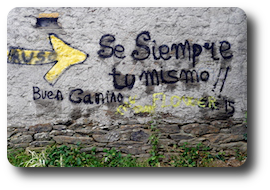 |
|
|
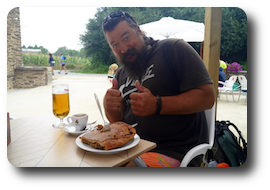 |
|
|
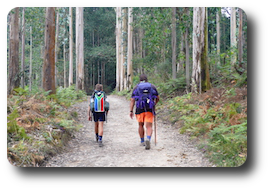 |
|
|
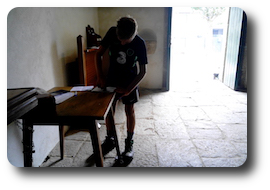 |
|
|
 |
|
|
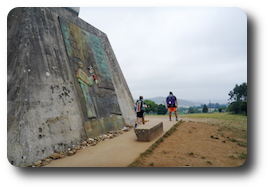 |
|
|
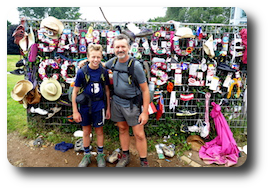 |
|
|
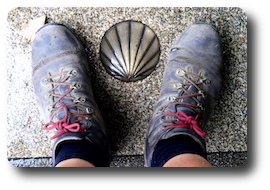 |
|
|
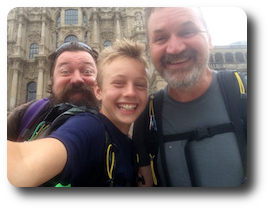 |
|
|
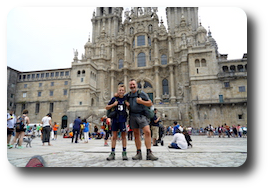 |
|
|
 |
|
|
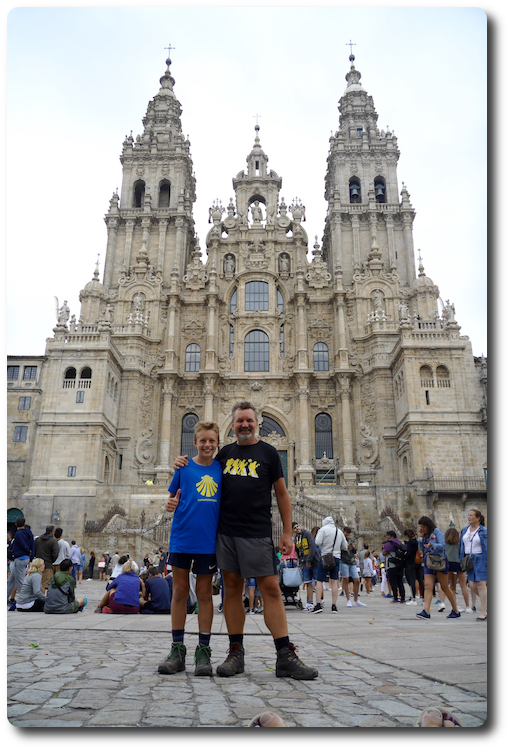 |
|
|
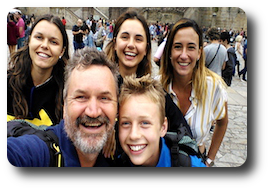 |
|
|
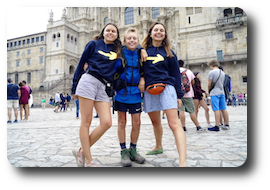 |
The end
 |
On our last day, almost poetically, we walked with Seán again, who we first met on day one and walked with on and off along the way. At the Cathedral we also met up with many other friends we had made along the way.
|